Yoshkar-Ola
And now, please have a look at this island, an island where we have everything!
The most absurd city in Russia is Yoshkar-Ola, the capital of the Mari El Republic. Neither Grozny, nor Norilsk, nor Ass-Fartsk can come close to it because Yoshkar-Ola is characterized not by poverty and dirt but by an overwhelmingly chaotic, psychiatric clusterfuck.
It tore me apart even at home, from the fact that all of this was orchestrated by my namesake — Leonid Markelov. I’ve heard a lot about what he did to this poor city and wanted to come here to have a good laugh. In the end, I came, but I didn’t laugh because none of it was remotely funny.
Crap and mosquitoes
As the car approaches the city, a foul smell permeates the vehicle.
I’m sitting in the back seat, and the Bla-bla-car driver says to his wife, “Once again, it smells like crap around here.” I understand that his wife is from Yoshkar-Ola, her husband is from somewhere else, and the smell of feces is an integral part of the region’s geography.
The driver explains, “It’s from the villages, maybe they’re raising horses or the sewage is bursting, who the fuck knows.” He explains it in such a colorful way that Yoshkar-Ola immediately appears in my imagination as Saturn, surrounded by a ring of shitty asteroids.
After some time, the smell of manure dissipates, and I reach the city. The next mess is swarms, crowds of mosquitoes, which inhabit residential areas in the city center in such quantities typically found only in swamps.
Mosquitoes swarm around my legs, arms, and face within seconds. It’s impossible to hide from them in the entrance of the building — they’re everywhere. I have to shoo away the mosquitoes from the door before entering the rented apartment, quickly close the door to prevent them from getting inside.
Okay, when morning comes, we’ll see everything.
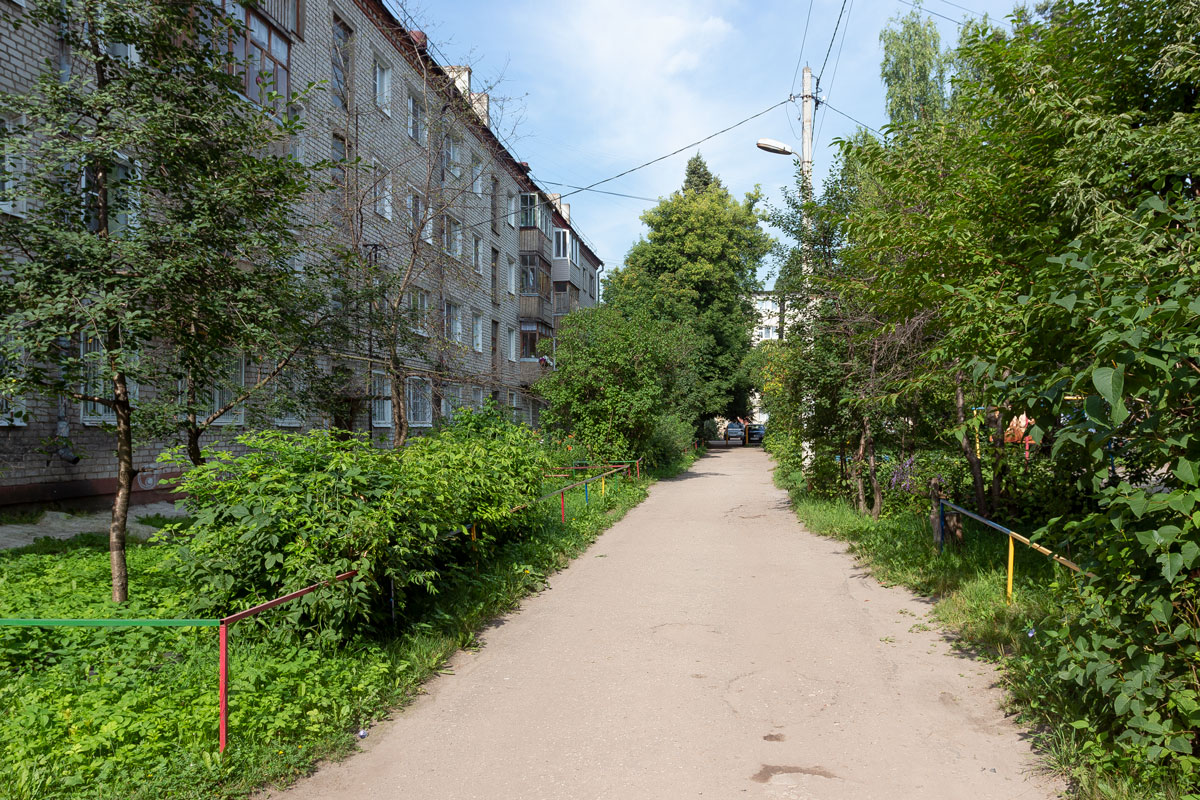
Sleeping republic
A branded taxi arrives in the courtyard, and children immediately run out from every corner to welcome it, saying, “Look, Yandex.Taxi has arrived!”
The thing is, neither Yandex, nor Uber, nor any other taxi service really works properly in Yoshkar-Ola. When Yandex started to appear here for the first time, local taxi drivers staged riots. They set fire to several cars at night and beat up drivers who accepted orders through the apps.
After that, it became dangerous to be a Yandex driver in Yoshkar-Ola. However, Yandex didn’t give up and came up with a clever plan. Every morning, a group of 5 cars arrives from neighboring Cheboksary, driven by lovely girls. Each evening, the taxis go back to Cheboksary.
Of course, this didn’t solve the problem. In the evening, you can only call a taxi through a local phone number, and the girls receive insults from local taxi drivers. But at least they are not being physically assaulted, and the cars remain safe.
Yoshkar-Ola turns out to be one large residential district. While other cities have a historical center with Khrushchev-era apartment buildings located further away, Yoshkar-Ola consists entirely of Khrushchev-era buildings, with the courtyards in a state of disarray beyond recognition. Truly, it is the most dilapidated city in Russia.
In the entire residential area of Yoshkar-Ola, there is not a single road or lawn. The entire city is simply filled with overgrown wild forest and five-story buildings.
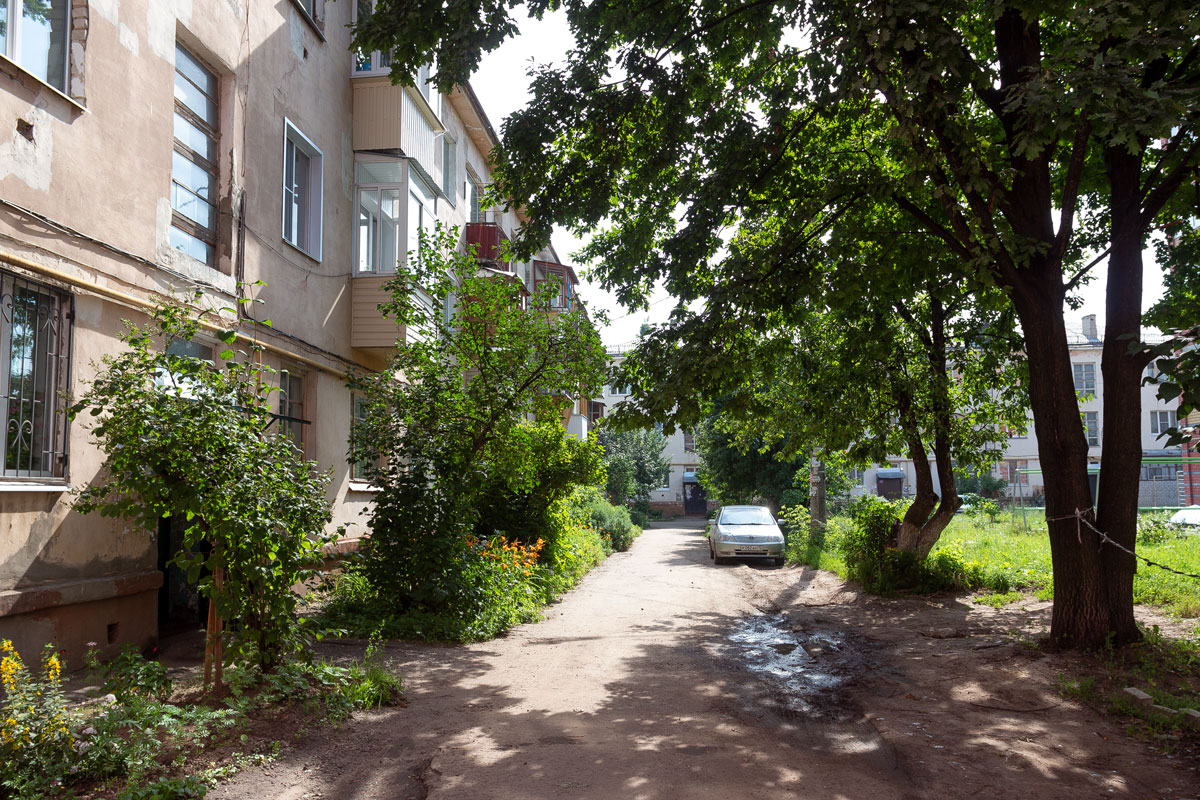
Yoshkar-Ola is the absolute asshole of Russia. Even in Pripyat, the asphalt has been better preserved — yes, I’ve been there.
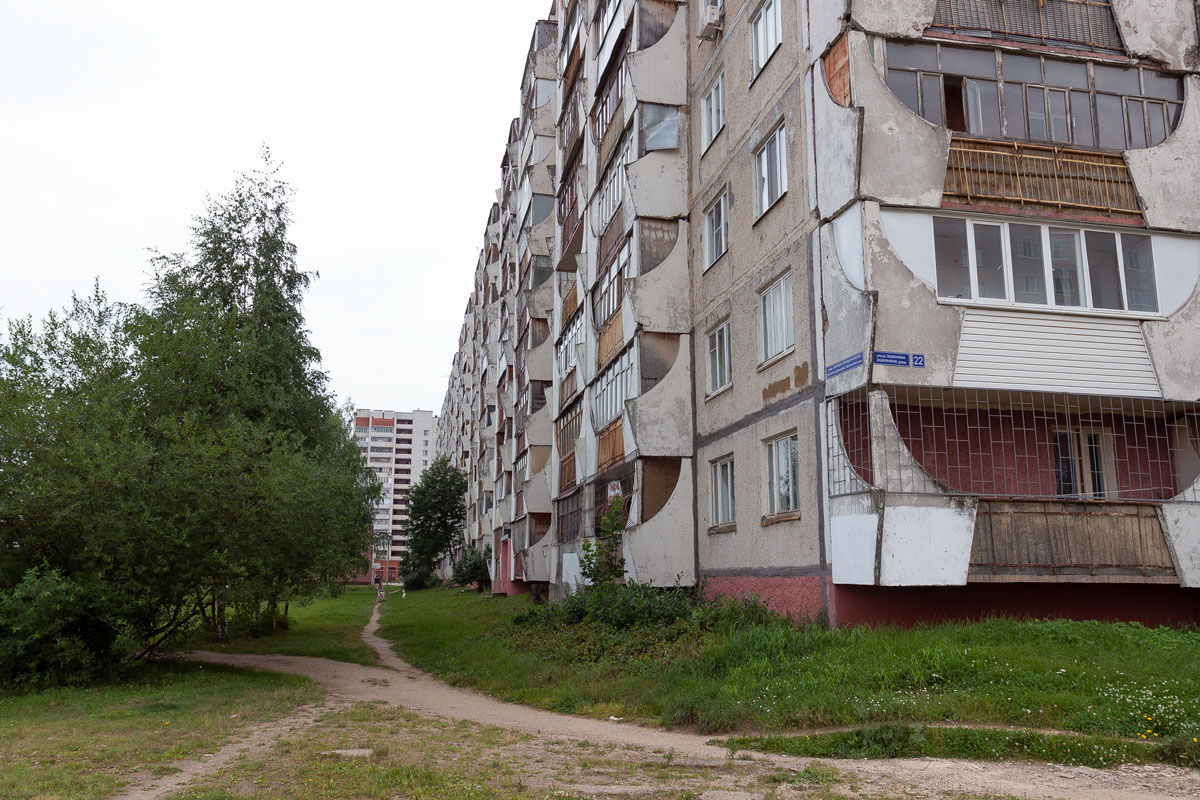
A typical yard in Yoshkar-Ola: rusty laundry frames that have been standing here since the Stalin era, and around them, overgrown wasteland. Naturally, there is no light at night. The electrification of the entire country came to a halt in the Mari El Republic.
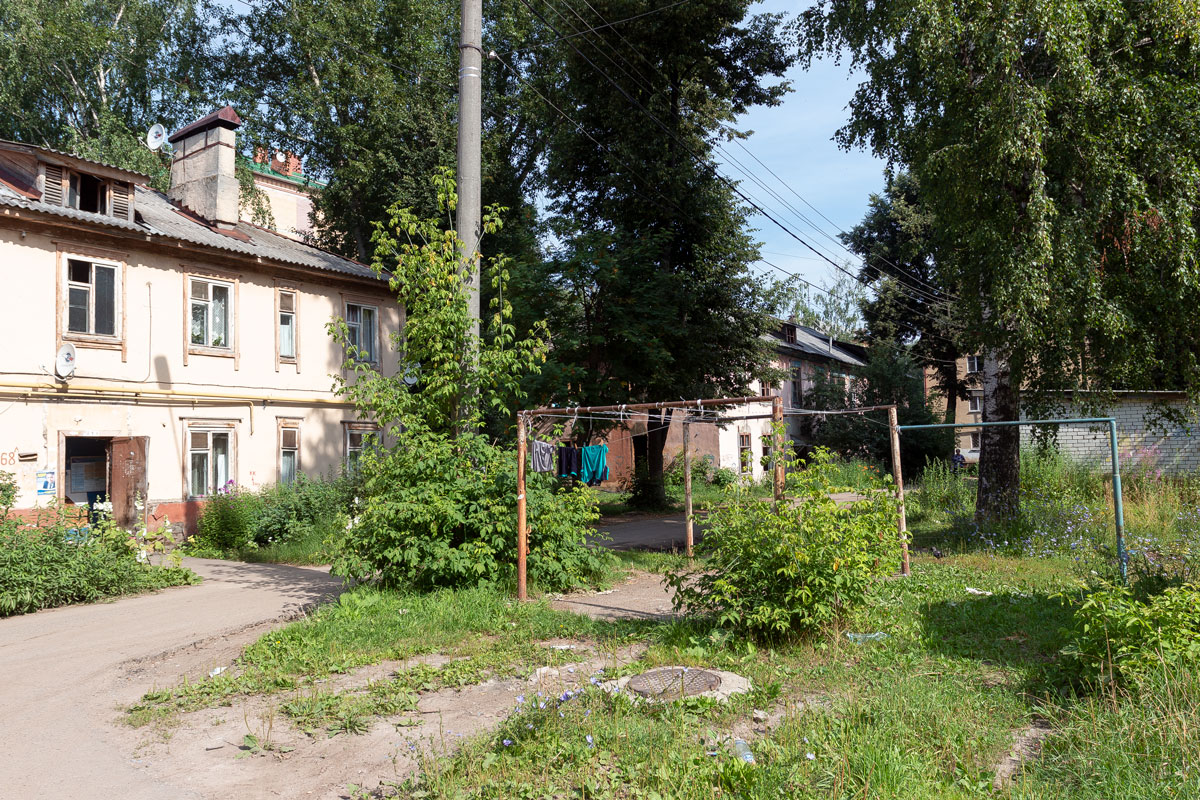
Rusty pipes run right above the street — well, where else would they put them, bury them in the ground? Repairing them is more difficult, of course.

Now let’s take a look at safety measures: in case of a fire, you can transfer to another building through a special balcony. I would rather burn alive than live in Yoshkar-Ola. But I’m not trying to persuade anyone, let everyone decide for themselves how to manage their own life.

Children’s playgrounds. And what the heck, they are not needed here, it takes 3 hours to get to Kazan anyway, it’s better there.
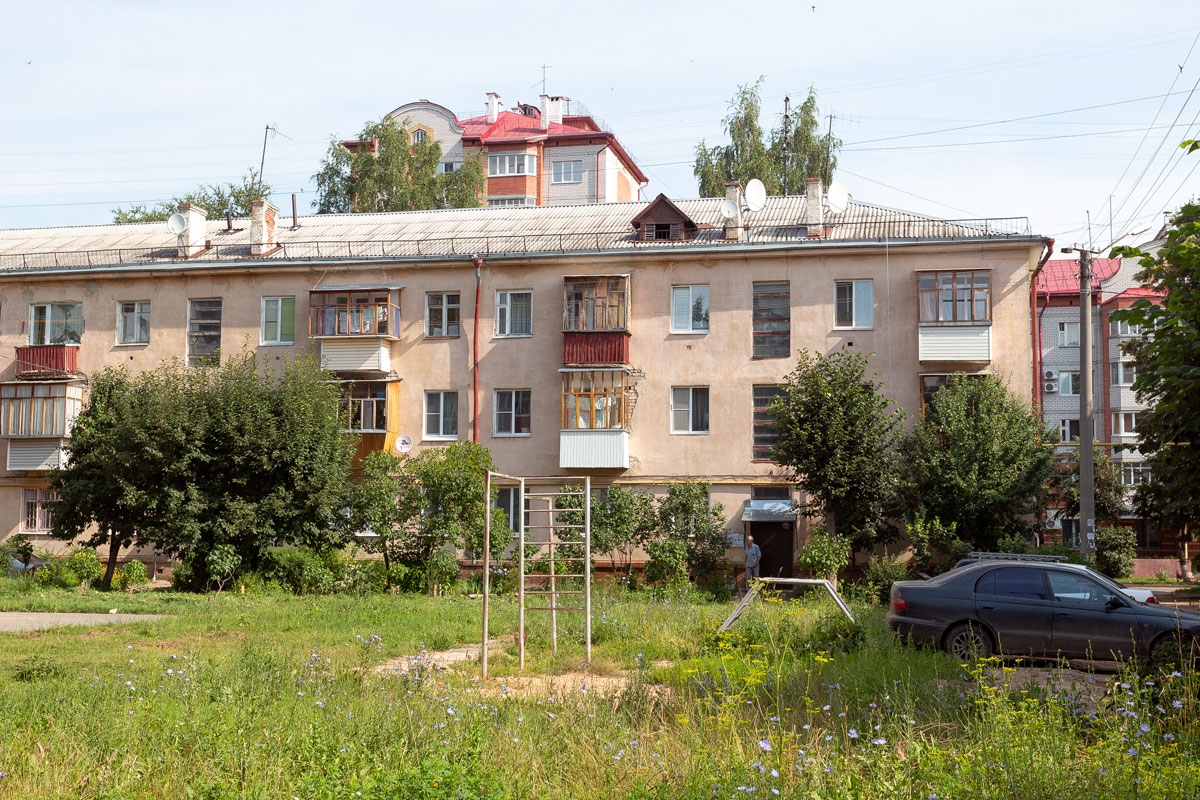

The reader may have a question here: it must be old neighborhoods, right? Not at all! If you want to see new buildings — please. They are all flooded with puddles of oceanic size and drowning in geyser-like mud.

Weak minibuses and battered buses circulate around the city.
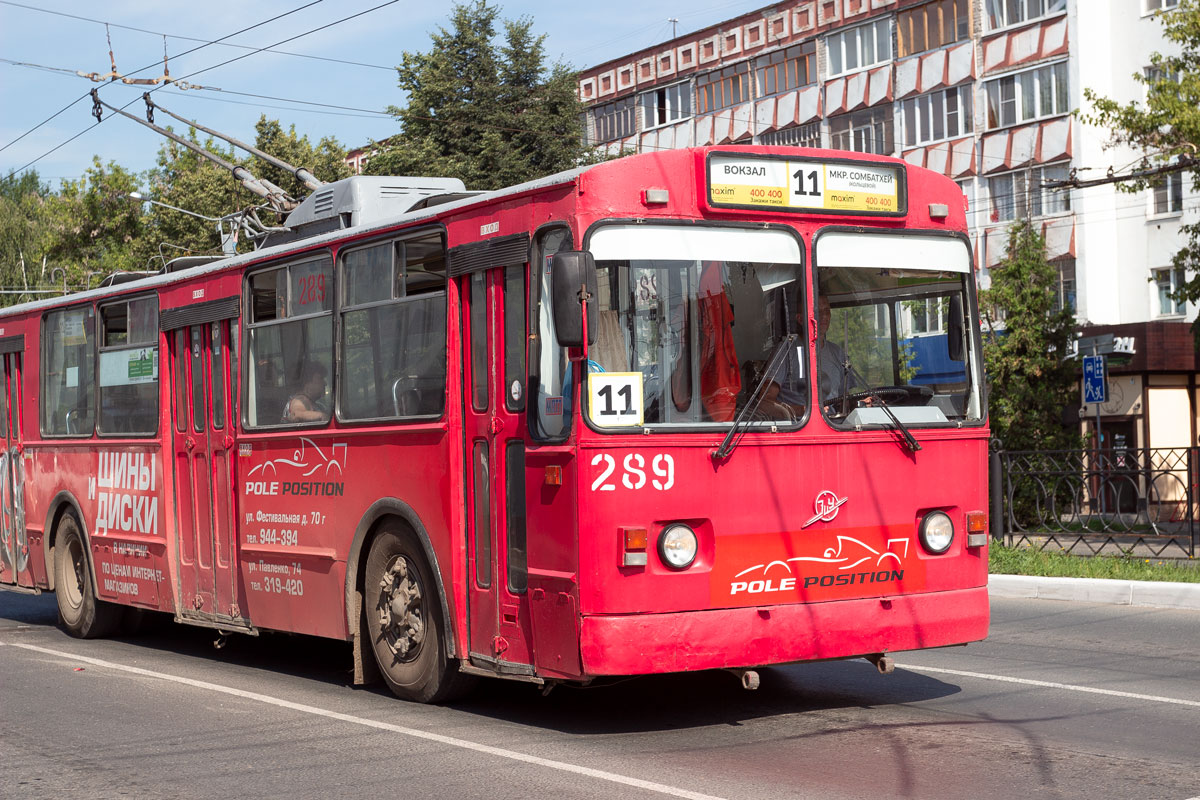
The national Mari architecture hangs on decaying Khrushchyovka buildings. The balconies in Yoshkar-Ola curve in a wild semicircle. Look how lovely: like wings on little angels.
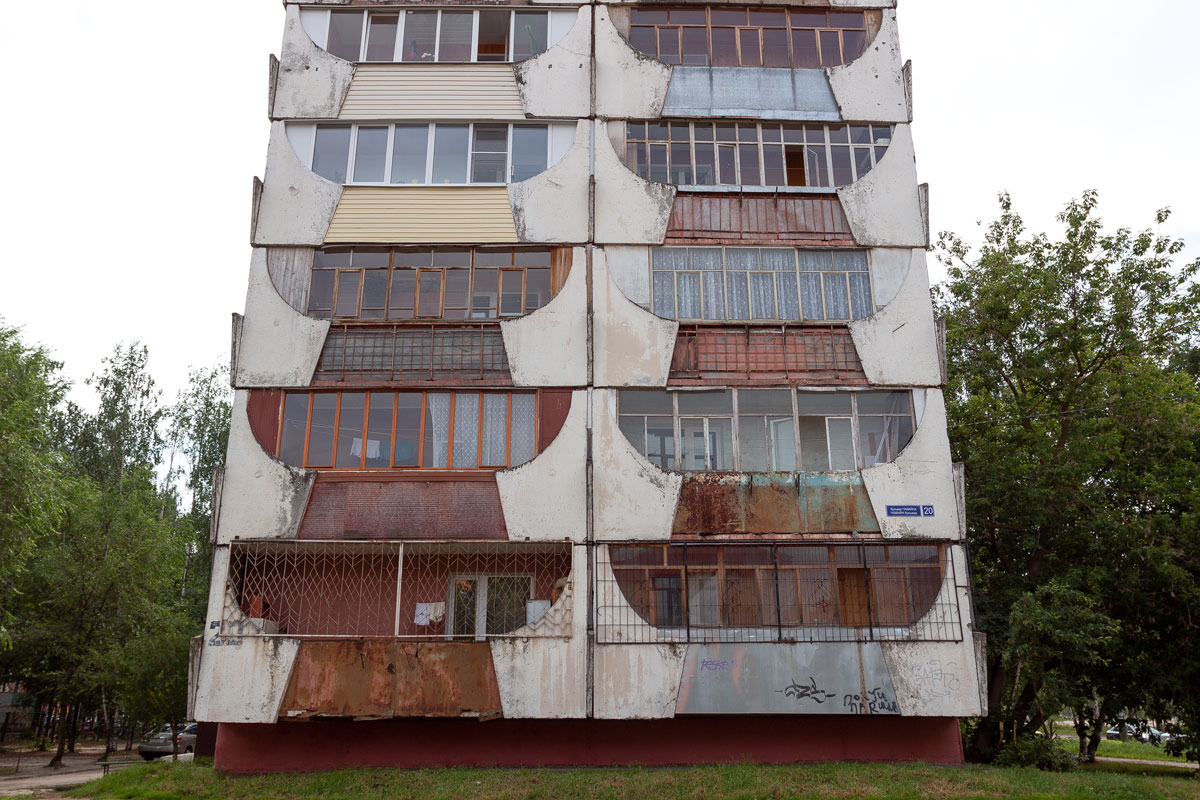
Alright, we’ve had enough wandering around the outskirts. Let’s go to the city center!
And what do we have here, the aftermath of a nuclear strike? The second radius of destruction, two hundred meters from the city center.
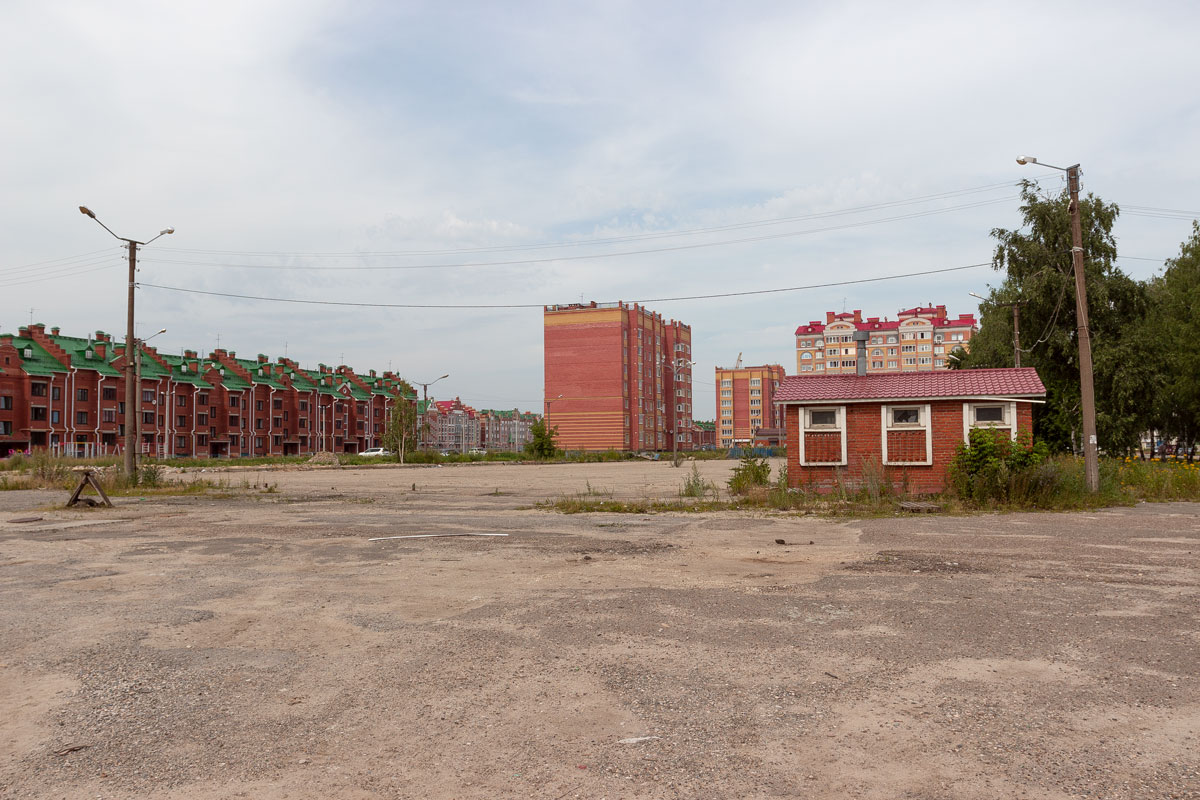
Approaching the center. The radius of destruction is 100 meters.
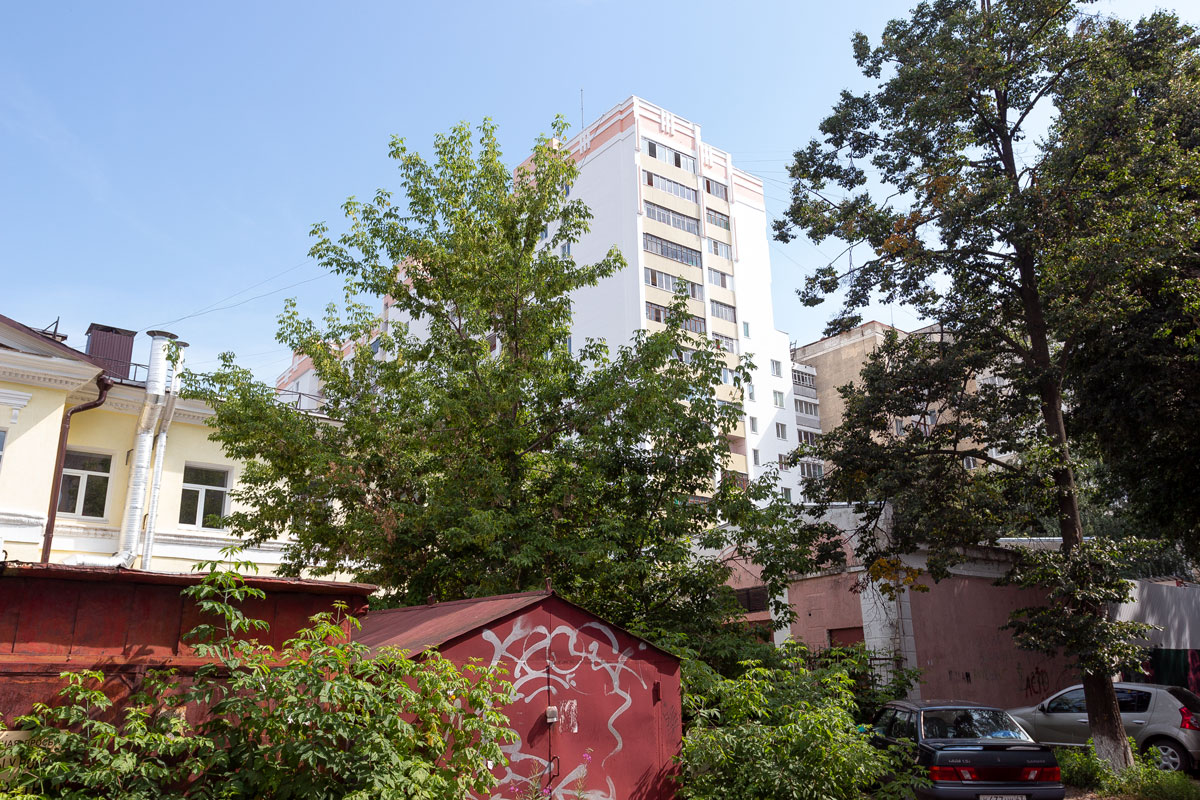
So, what is that peeking out over there? Such towers!
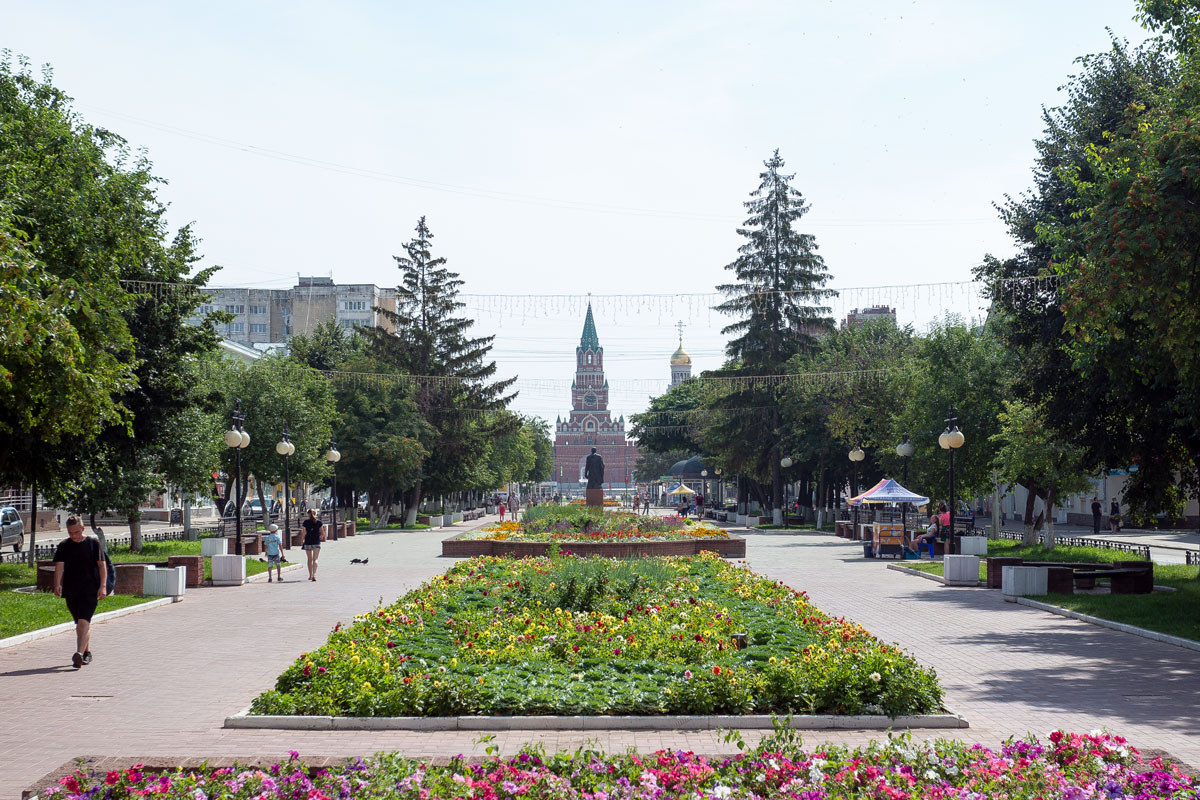
And this, damn it, is the center.
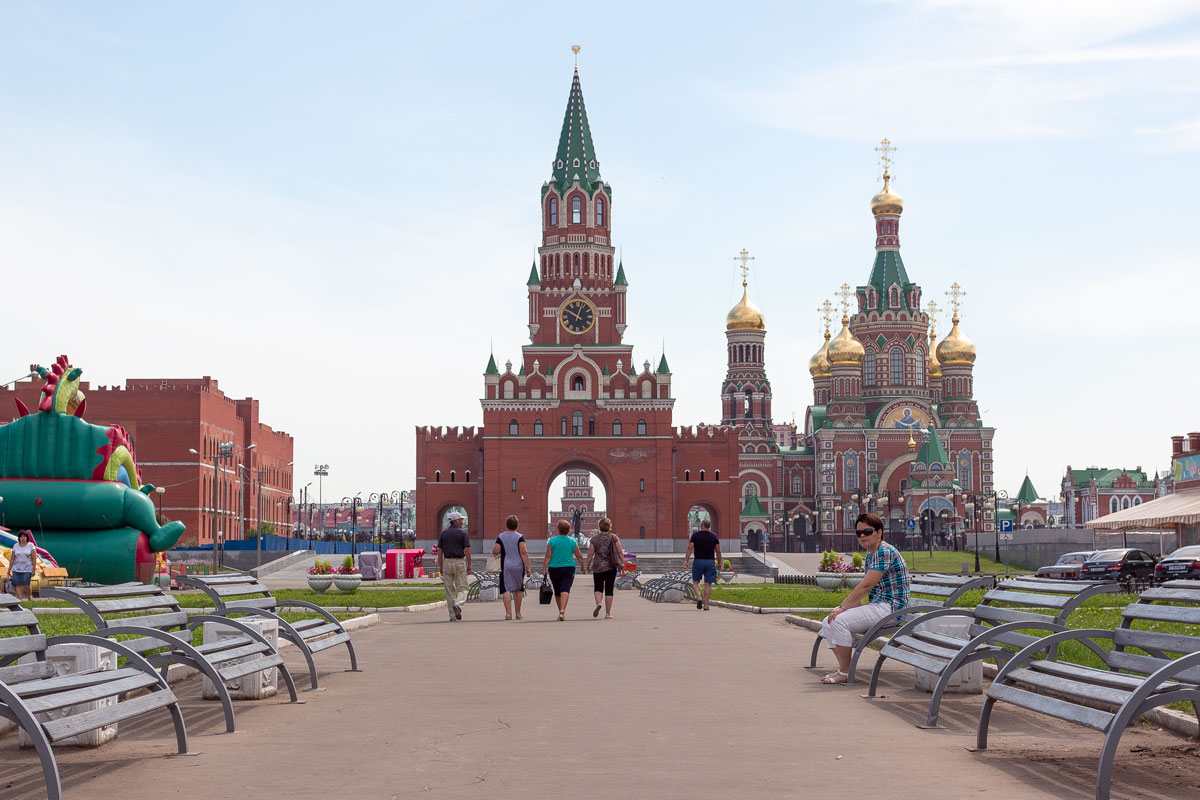
This is the fucking center of Yoshkar-Ola!
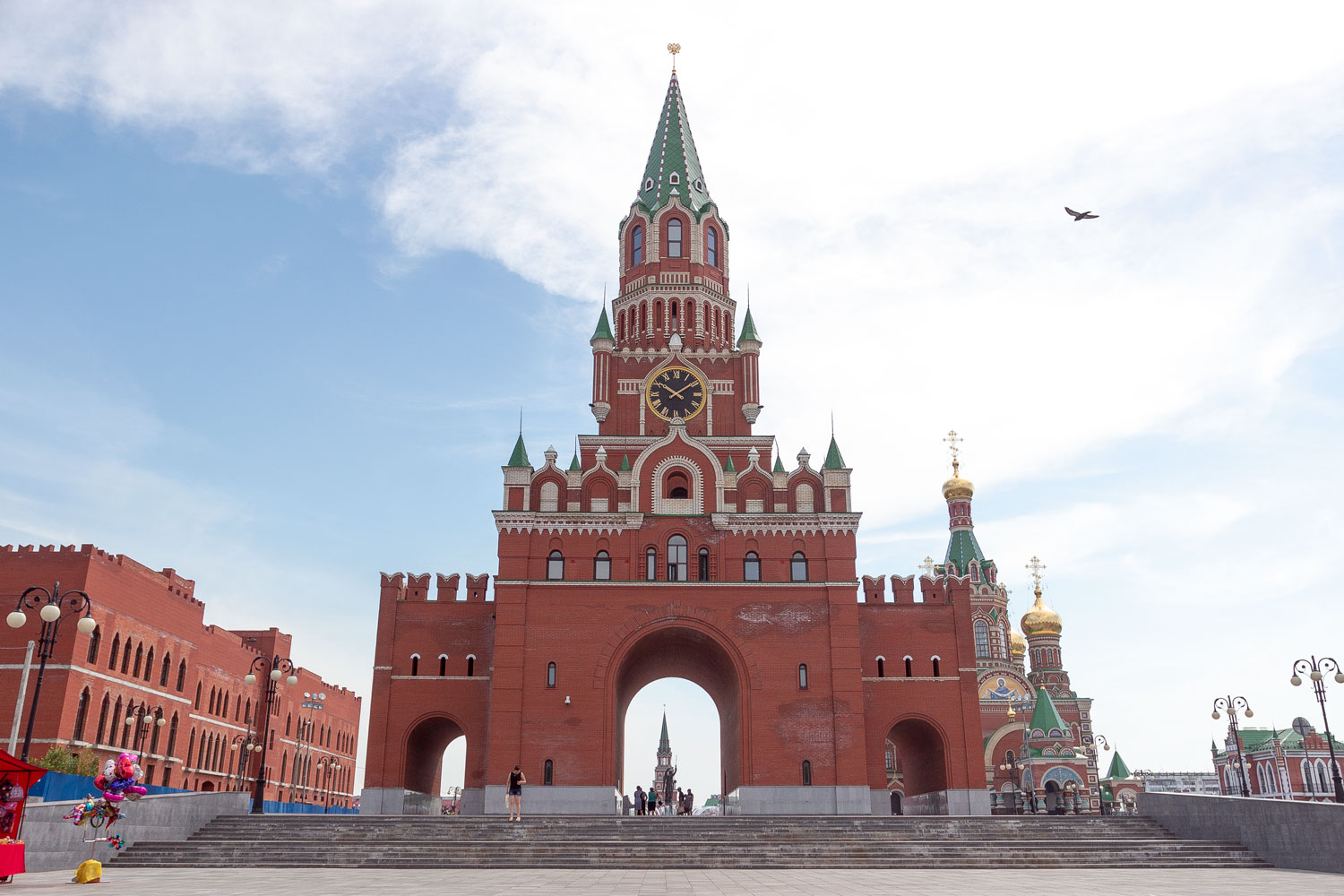
Entering the zero radius of destruction. The epicenter of the explosion has been detected.
Kremlin
In short, I will explain everything now.
The thing is, the former head of the Republic of Mari El, well, that one who shares my last name... he’s a bit... well, a bit... philosophical. No, seriously. He’s a candidate of philosophical sciences. That’s what it’s all about.
When Markelov, in 2001, gained power over an entire republic, he philosophically reasoned that it happened to him not because of ballot stuffing but as a result of divine providence. And there’s this fortune-teller who predicted that Markelov would escape death if he built 7 churches in the city. That’s what the locals say.
That’s when Markelov got carried away and decided not only to build churches but also to turn Yoshkar-Ola into a tourist mecca of Russia. How? Well, that wasn’t even a question! Of course, by constructing a replica of the Kremlin. Made of bricks.
It may seem like I’m joking quite hilariously, but the thing is, I’m completely serious. Let’s take a closer look together at who this character, Leonid Markelov, is.
Take a look, he writes poems. Quite revealing ones, from which one can understand what the mayor truly feels and what he is concerned about.
The fragile castle of crystal,
Not wishing to listen to the reasonable —
They thirst for the ship’s doom.
And to whom should I turn in my prayers
And ask: why and for what?
Familiar and stony faces,
And I am needed by no one.
Well, do you understand now that power is a dangerous thing?
So, Leonid Markelov decided to build a replica of the Moscow Kremlin in the center of Yoshkar-Ola. But here’s the catch: there are no decent architects in the republic! He tried to contact the Italian Fioravanti, but the necessary mushrooms were eaten by mosquitoes.
What to do then? How to avoid the predicted death?
Nothing to worry about, as it is God’s providence. In that same year, 2001, a silica brick factory appears right in the center of the city.
What a, damn it, stroke of luck! And it’s not far to carry either!
In that same year, the heaven-sent factory produces its first batch of country-style bricks, from which Markelov, to the glory of the Lord, constructs the first ziggurat — the Spasskaya Tower.

The Spasskaya Tower alone is not enough — one tower won’t attract tourists. Another Orthodox church is needed, something like the Church of the Savior on Spilled Blood in St. Petersburg. But how to build such a massive structure with just a pile of bricks? Markelov doesn’t lose hope: he will construct it from bricks, for everything is according to the will of the Lord.
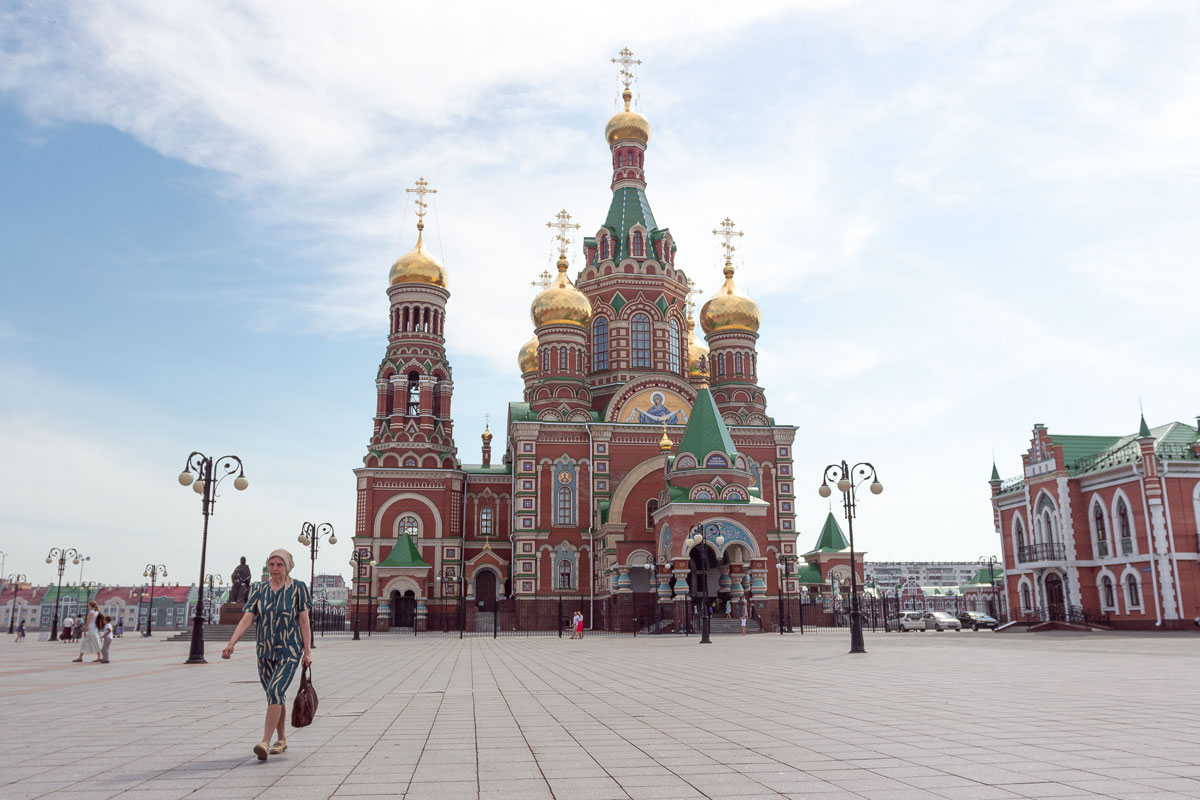
The powerful tourist flow that is about to flood Yoshka now needs something to sustain it. How can we feed them, having only a ton of bricks? Performing a miracle like Jesus feeding a whole city with a loaf of bread? No, well, that’s too much. But restaurants made of bricks can be built.
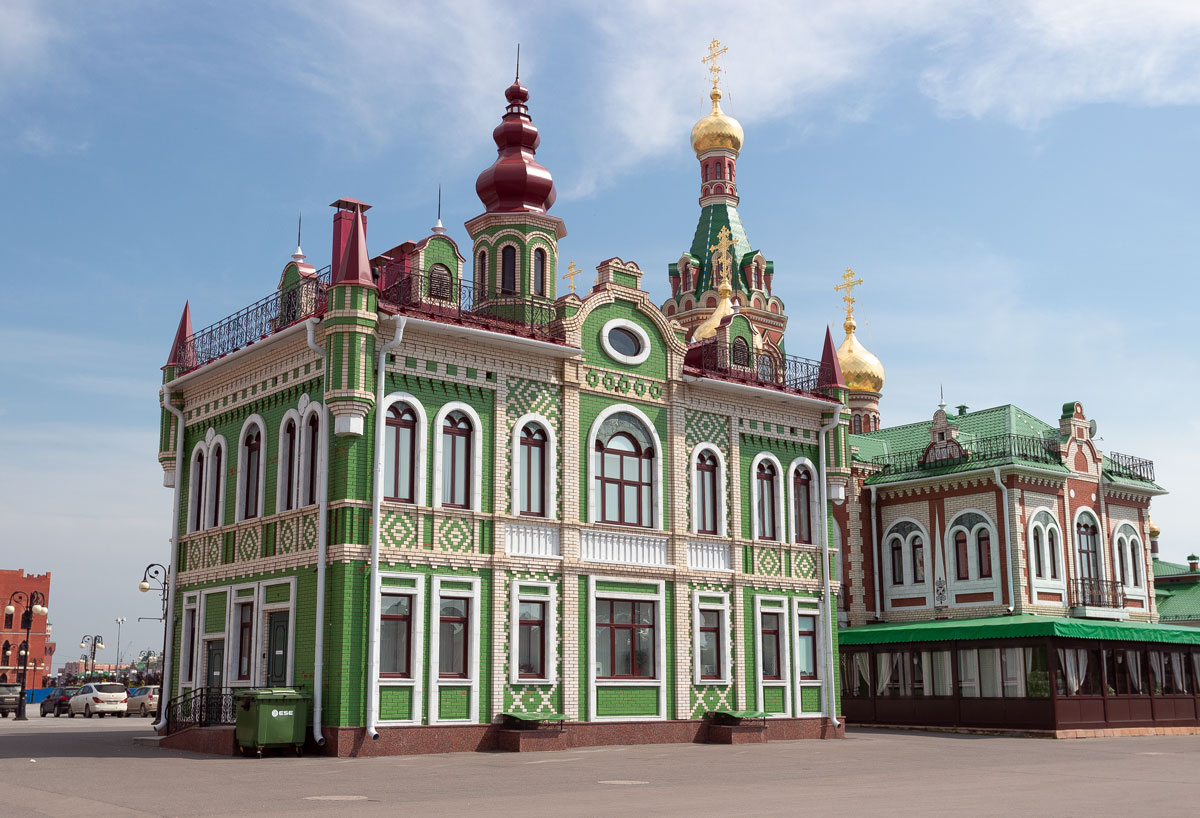
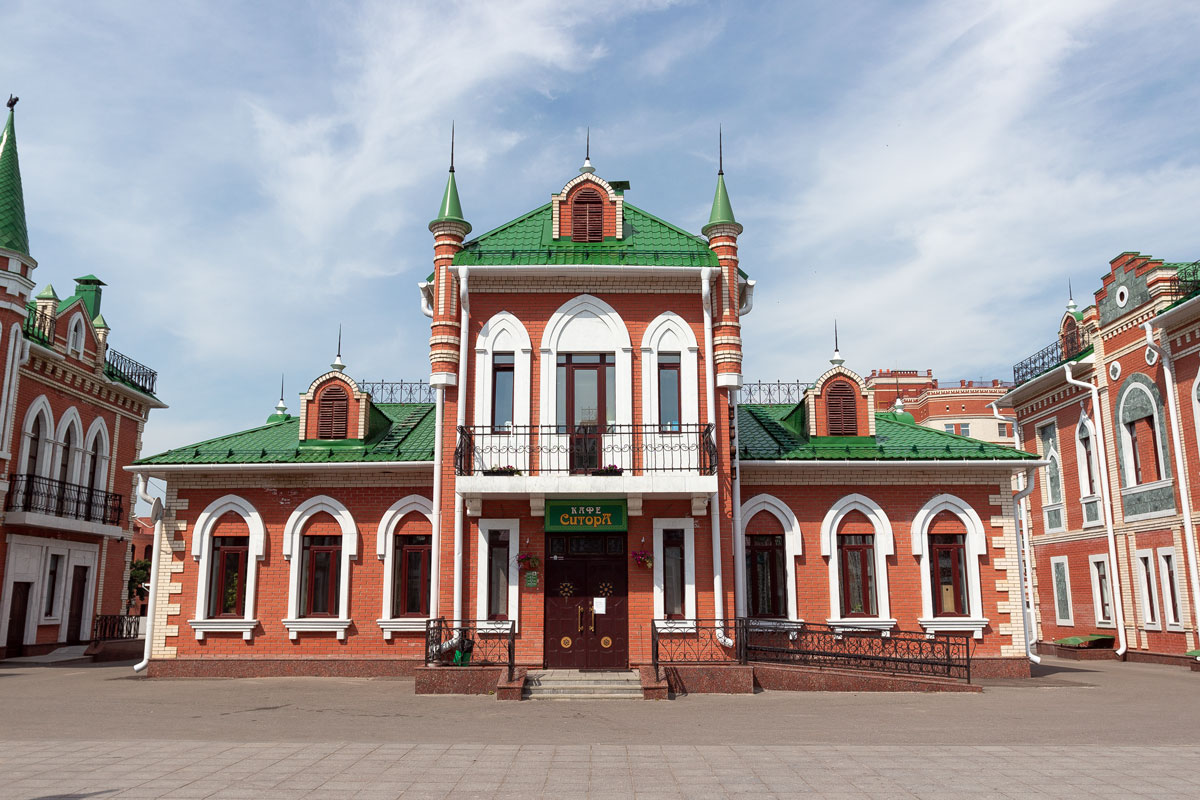
My friends. As I mentioned before, I came to Yoshkar-Ola to have a good laugh at all this madness. I thought that when I arrived, I would see it all and walk around while clutching my stomach.
So, it turned out to be not fucking at all funny. I just walked around with a stone face, looking at all this clusterfuck and couldn’t laugh or cry. I was simply paralyzed.
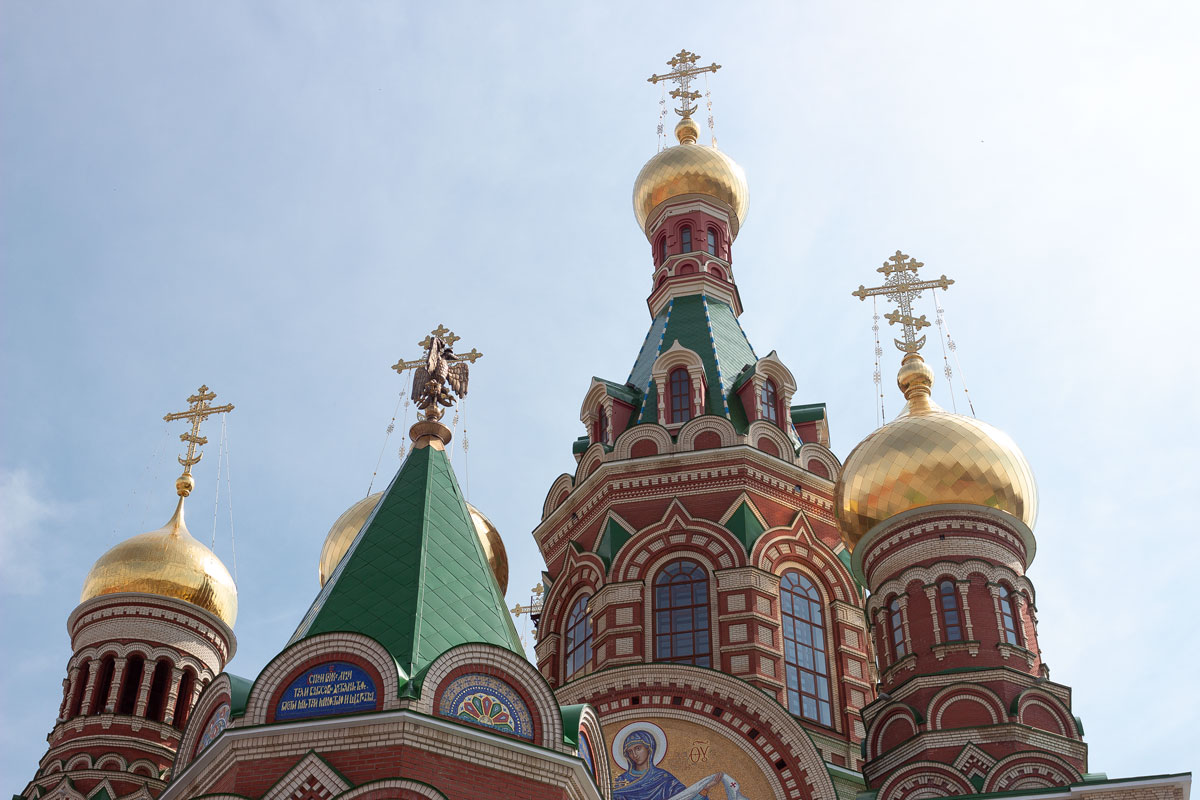
To top it all off, there was also a smell of excrement on the territory of the Yoshkar-Ola Kremlin, just like at the entrance to the city. Apparently, they decided to copy the sewer system as well. From 15th-century Italy, it seems.
However, what will surprise you the most if you decide to visit Yoshkar-Ola yourself is that people actually go to this cathedral made of country-style bricks, light candles, and pray.
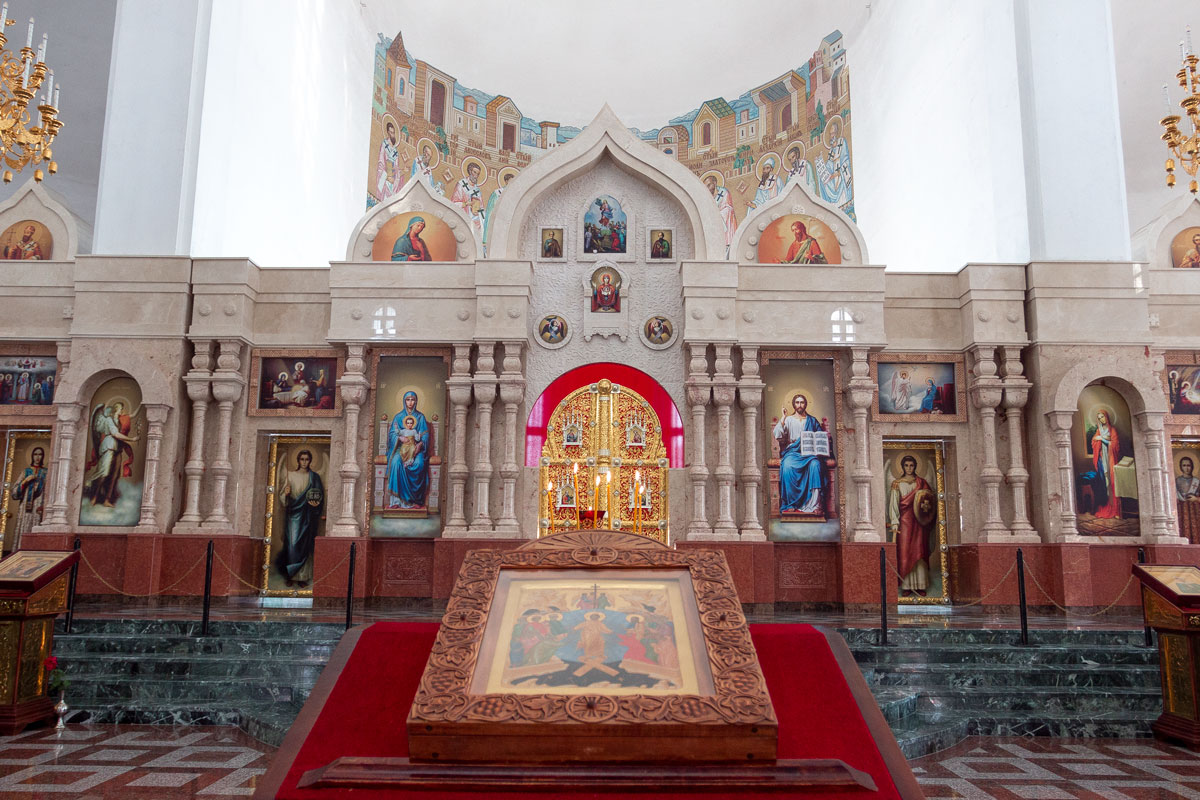
It seems that Orthodox Christians don’t give a fuck about anything at all. If there’s a church, it’s fine, whether it’s made of bricks or cow dung.
In the Bible, there is a criminal article that says: “You shall not make for yourself an idol or any likeness of what is in heaven above or on the earth beneath, or in the water under the earth. You shall not worship them or serve them, for I, the Lord your God, am a jealous God.”
But who among the Orthodox actually reads this little book? A woman comes out of a brick church, approaches a monument to the Holy Virgin, cast from cheap bronze according to some idiot’s design in 3D Max. She stands in front of it and crosses herself!
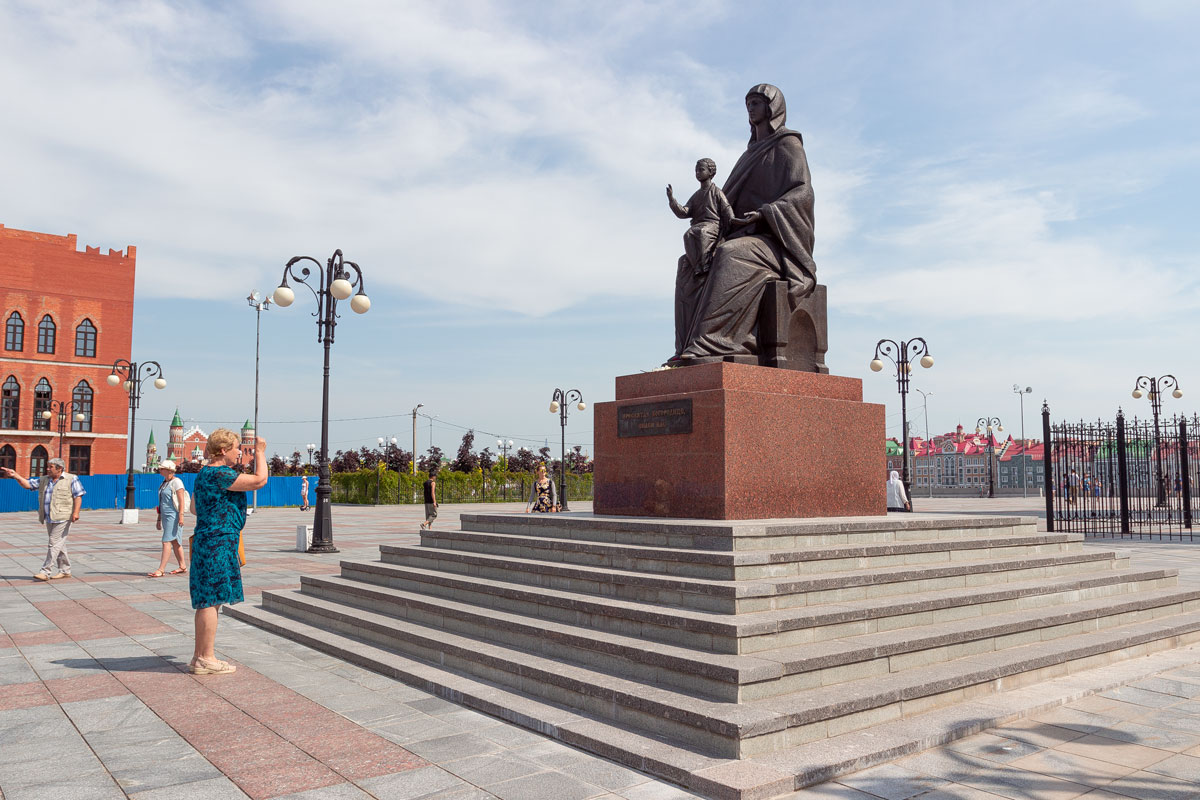
Fuck, Christians don’t worship monuments! It’s heresy, polytheism, the creation of idols. Even icons, in their essence, can be seen as idols, but prayers in front of icons are understood as part of culture and religion. However, worshiping bronze statues is heresy.

Yoshkar-Ola against Europe
When I exited the “cathedral,” it seemed to me that I had explored the city. It was an illusion: Yoshkar-Ola was just picking up steam. The dung Kremlin and brick church were surrounded by a river, with a bridge crossing it, and along the river embankment stood a long row of houses.
This was a new architectural copy, taken by Leonid Markelov, this time from the Belgian city of Bruges. It looks quite nice here, doesn’t it?
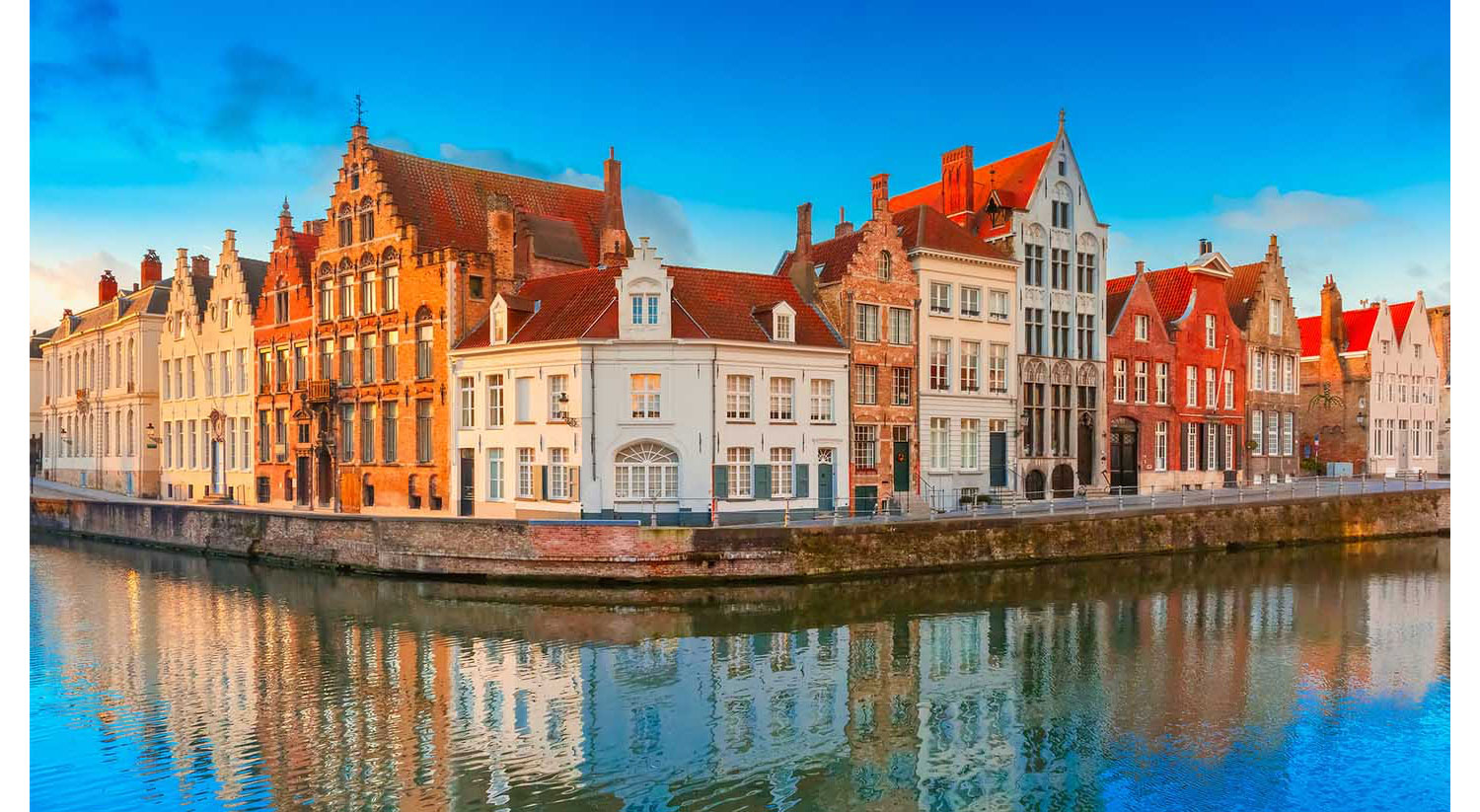
Ah, my mistake, it’s actually Bruges itself. It’s very difficult to distinguish between the two cities!
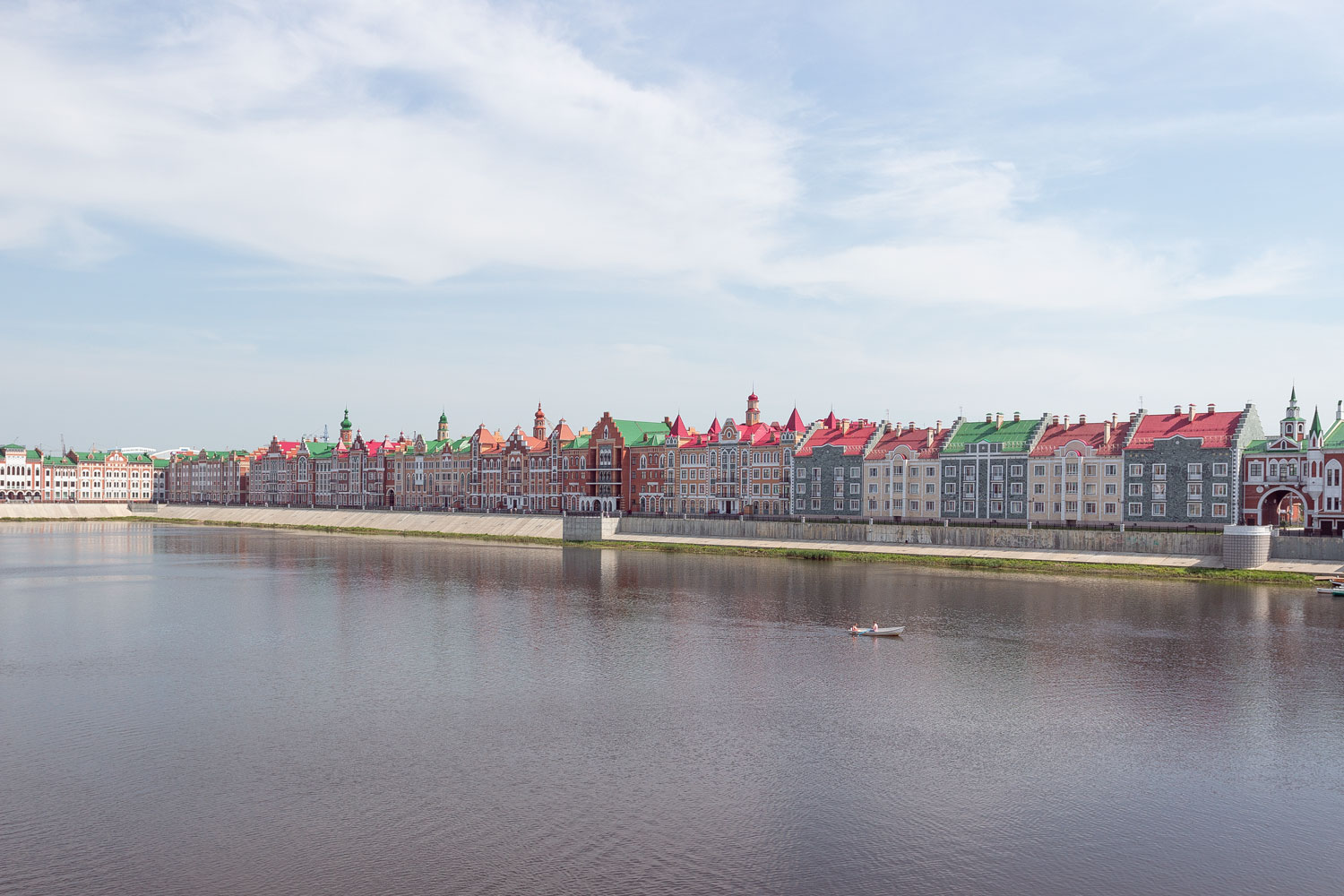
Reader, please understand that Europe is a very poor country. After all, why did Venice and Amsterdam emerge? It’s because there was so little land to live on that “gayropeans” started settling directly on rivers.
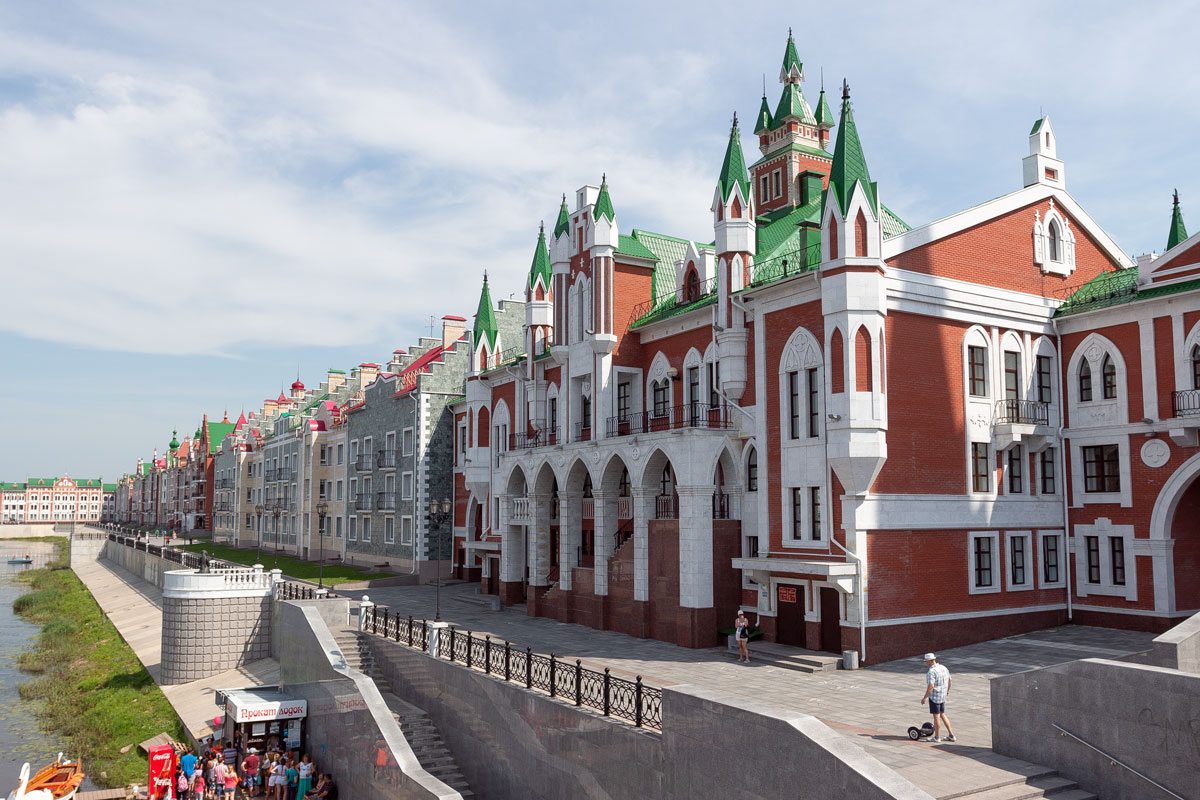
But one thing these bastards are good at is PR! They promoted their Venices, fed the world with lies, claiming how amazing it is to have a city on water! How cool it is to have narrow alleys!
In reality, these rivers are full of nothing but mosquitoes and mold. I haven’t been to Venice, of course. But in Yoshkar-Ola, I’ve seen mosquitoes and mold. Are they nonexistent in Europe? Is it some kind of sacred place where they don’t multiply?
As for narrow alleys, I don’t see anything cool about them. Look at Russia with its wide streets, avenues, and bridges. It’s not poor Europe; it’s the Empire!

And the rivers in Russia are powerful, unlike those European streams. Take a look at the Malaya Kokshaga River. See how huge it is! Rare birds won’t even fly halfway across the Malaya Kokshaga. And that’s just the small one, you should see the Bolshaya Kokshaga!
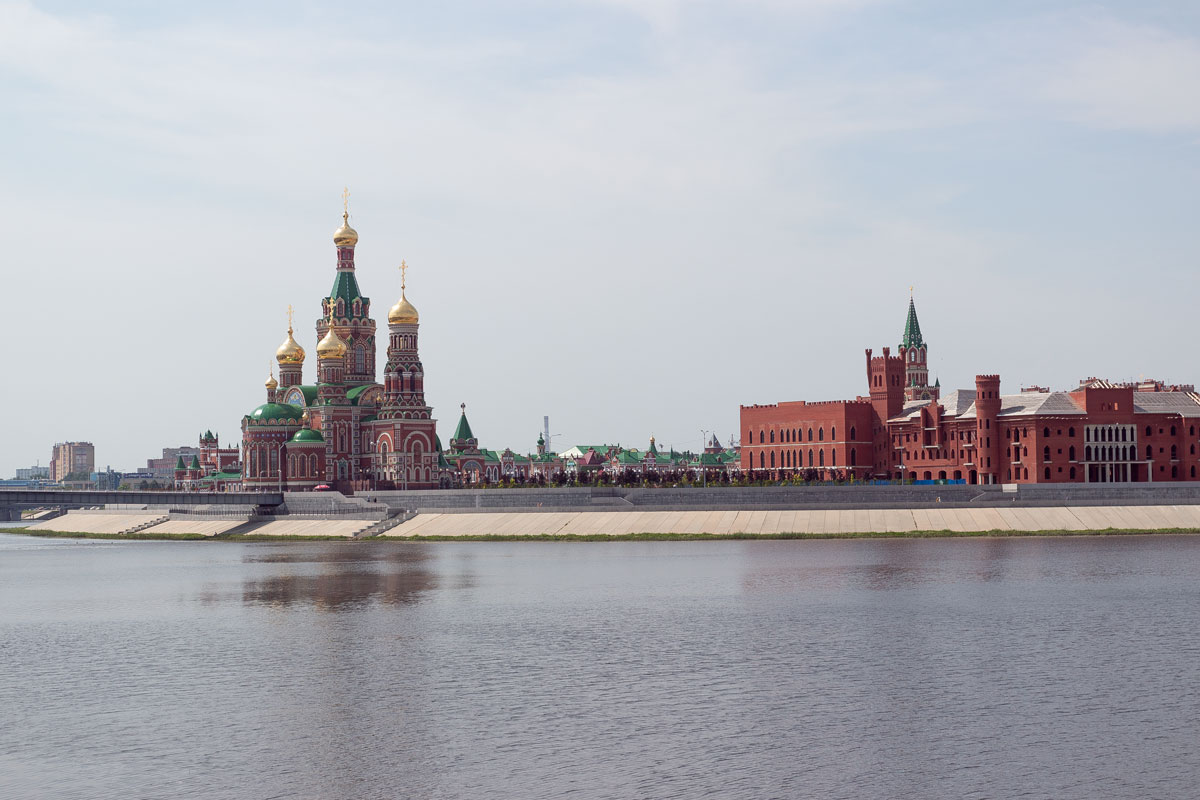
Here, I myself have already stopped understanding if I’m writing this seriously or not.
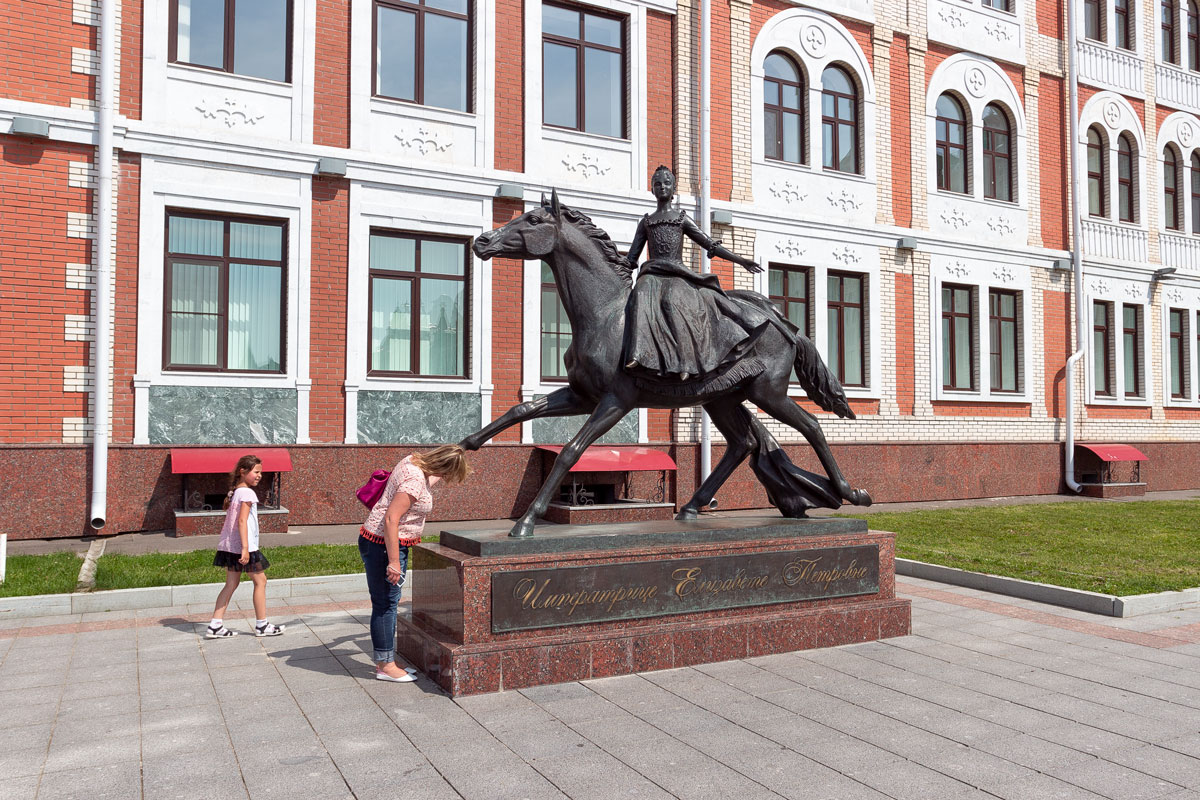
Twelve shot knees of Israel
Yoshkar-Ola didn’t even think about retreating; on the contrary, we were approaching the epicenter of a nuclear brain explosion. I meant to say, the center of the epicenter. Since no one knew in advance how deep this rabbit hole goes.
What were we destined to see? What was supposed to make our ears burst and our eyes bleed at last?
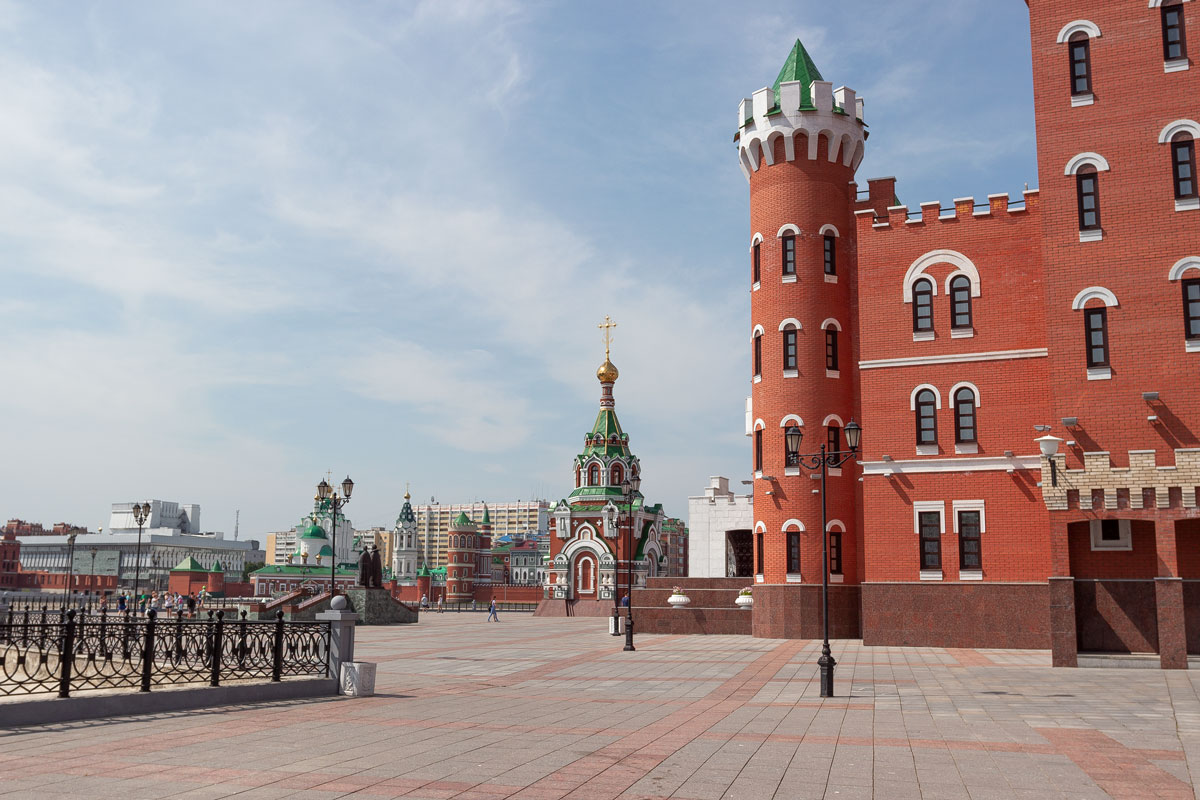
Oh, we were about to see the main Holy Relic of Yoshkar-Ola, for which Orthodox pilgrims from all over Russia gather here.
Huge crowds of people were already gathering around the large brick castle, its spires towering high above the city. Their shadows marched along the asphalt like clock hands, counting down the time until noon.
In the warm summer air of Yoshkar-Ola, there was a noticeable tension, and the atmosphere suddenly became as if electrified by some unseen force. Such a force, presumably, is experienced by a sincerely praying person when their prayers are heard by God. The transcendent, incomprehensible feeling made the crowds freeze in stupefaction.
All of them, who just a minute ago aimlessly wandered along the embankment, now gathered together and stood in place, gazing somewhere up high, at one of the floors of the brick palace.
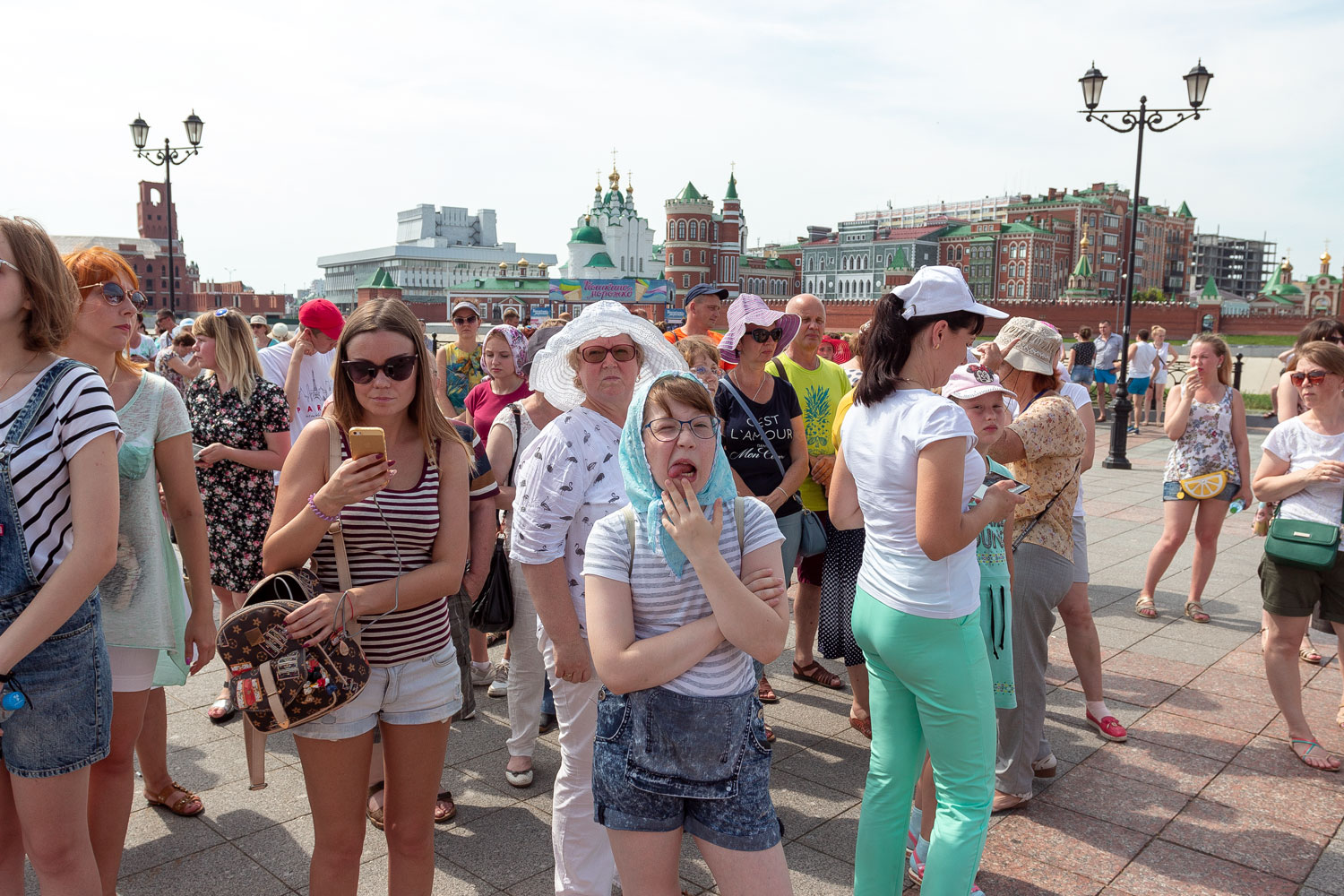
Suddenly — it began. The castle doors, which seemed impenetrable decorations, suddenly swung open, and figures streamed out in a procession, controlled by a clever clockwork mechanism.
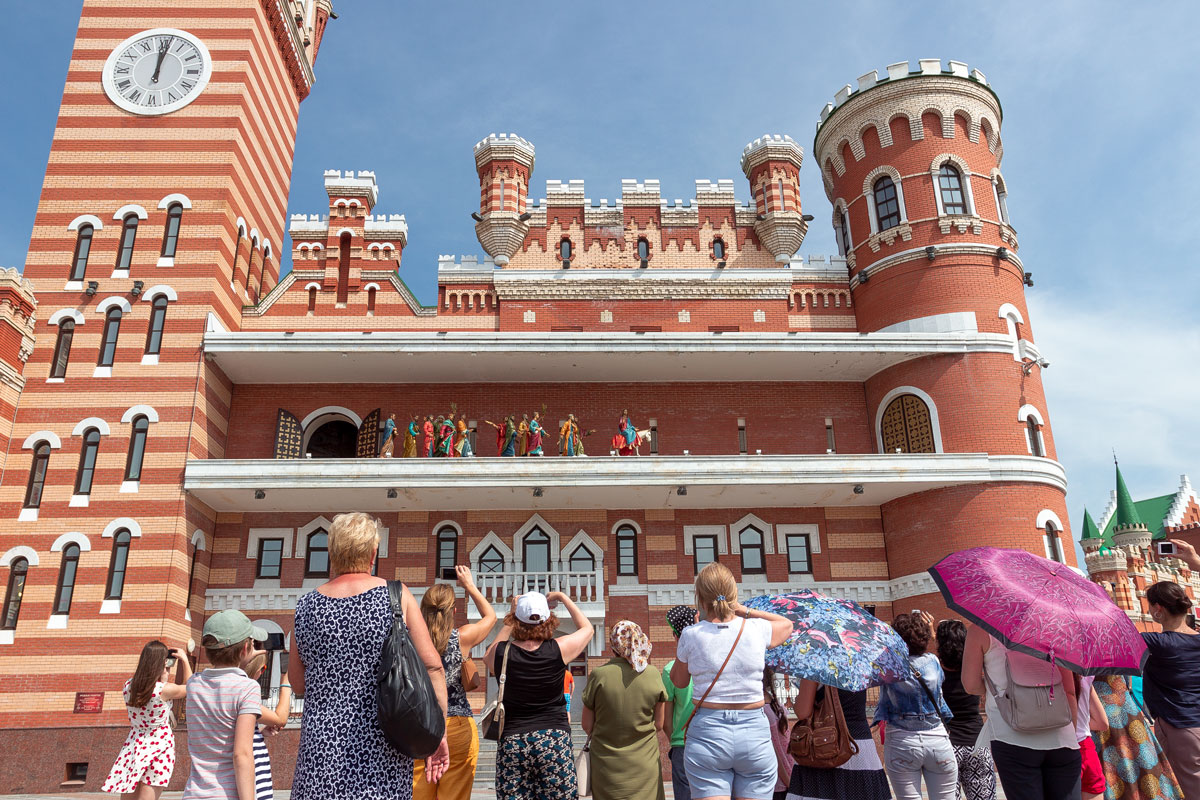
“Wow, these are the ‘12 Apostles’ clock from Prague,” the thought raced through the author’s mind. “Better!” The guide responded aloud, reading his thoughts. "Much better, my dear friend! Those Czechs built their clock so long ago, in 1410. Do you really want to travel to the ends of the earth just to look at this old stuff? And they’re hung so high that you can’t make out a thing! If they’d hung them lower, they would surely have been stolen by thieves." “Looks like someone stole from someone else,” a voice in the crowd retorted. “Exactly, exactly, my friends! Besides the fact that the Prague clock is blatantly old, it’s also just plain ugly. Look at how these figures are painted. And they are not made of bronze, but of modern materials. It was only thanks to Leonid Markelov that we were able to not just replicate but surpass the original.” “Wow!” the crowd exclaimed. “But even in absolute terms, our clock is much better than the one in Prague. Our mathematicians calculated that if the statues were to walk on the ground, in 35 years they would have walked from Yoshkar-Ola all the way to the Temple Mount in Jerusalem!” “Divine providence,” the crowd whispered. “Take a picture, fool, when will you see this again!”

“Take pictures!” — could be heard from the crowd here and there.
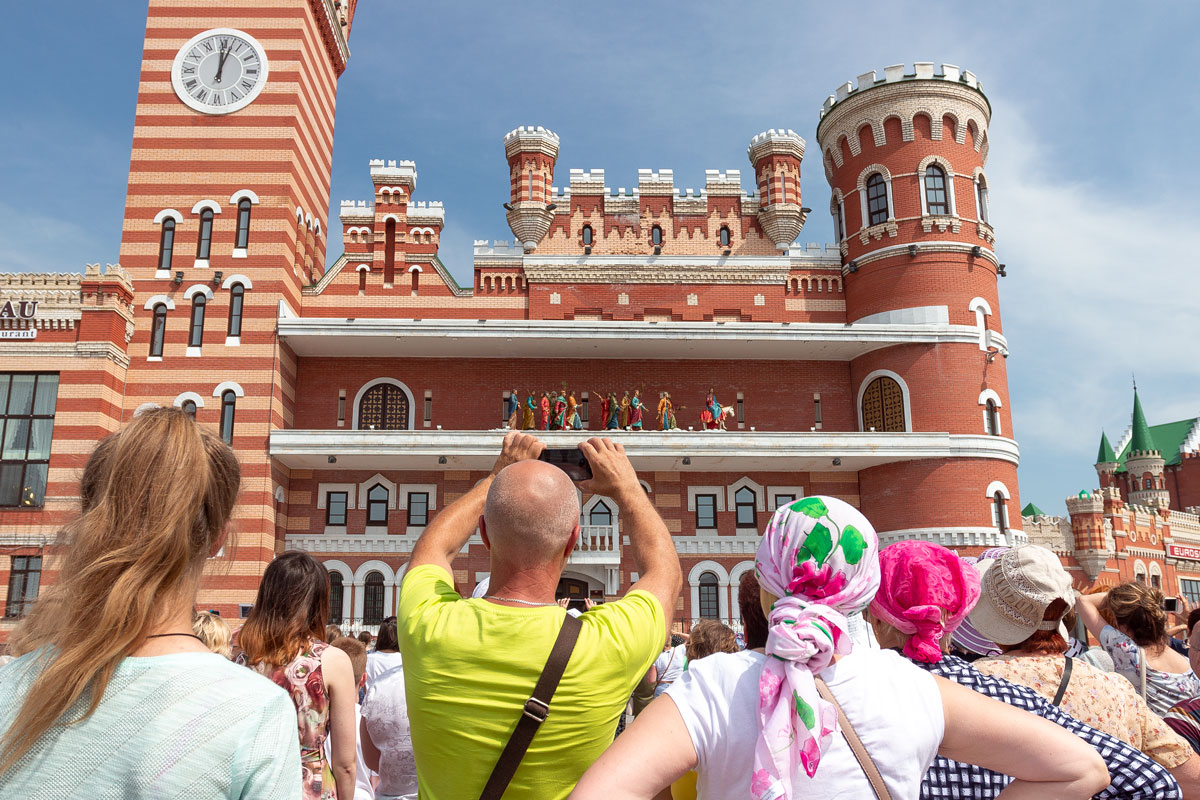
“PHO-TO-GRA-PH!” — the thunderous bass of church singing resounded menacingly in the atmosphere.
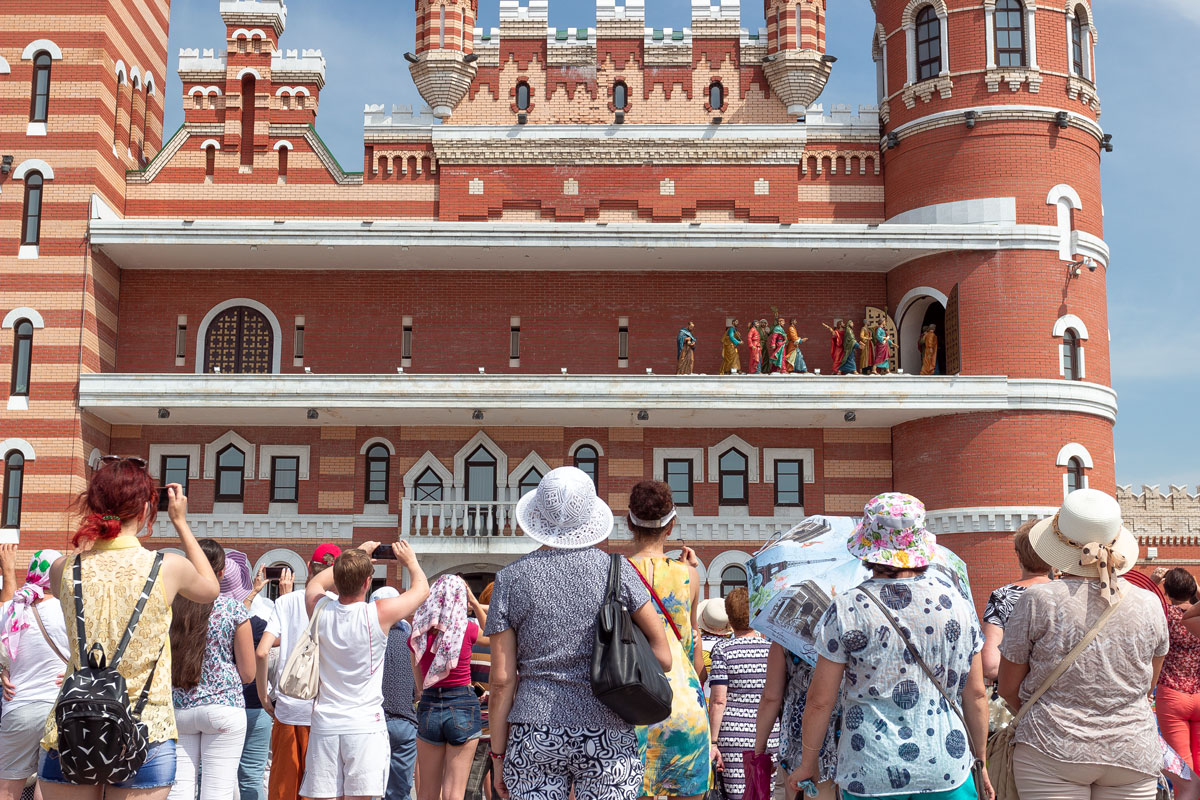
The crowd pulled out cameras and phones, traced the crucifixion symbol on the lock screen with three fingers, and took photos.
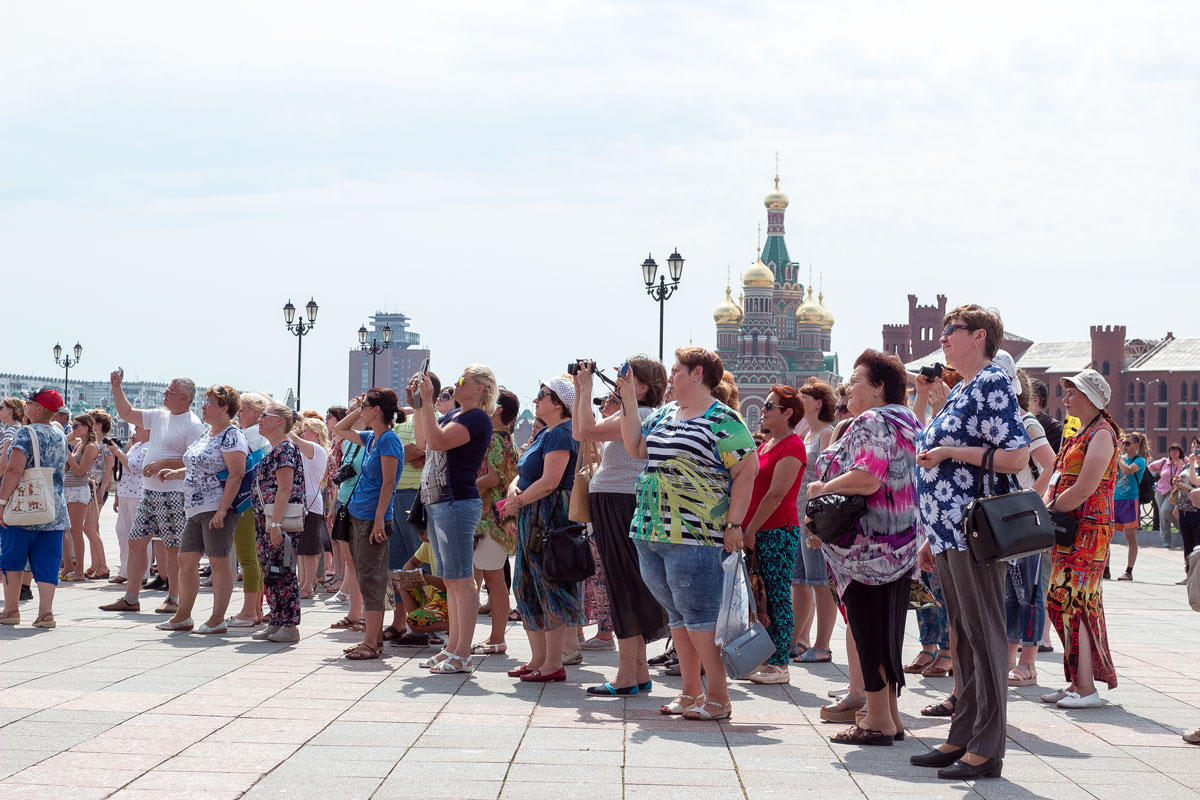
Then suddenly the electrified atmosphere vanished, voices died down, and the figures, after making a final pirouette, disappeared into the castle doors.
The mind-burner, disguised as a cross on the head of Alexei the Second, ceased its operation.

Holy martyr Leonid
Of course, one day was not enough to explore the entire Yoshkar-Ola. Tourists are given a city guide stylized as an ancient Germanic map.
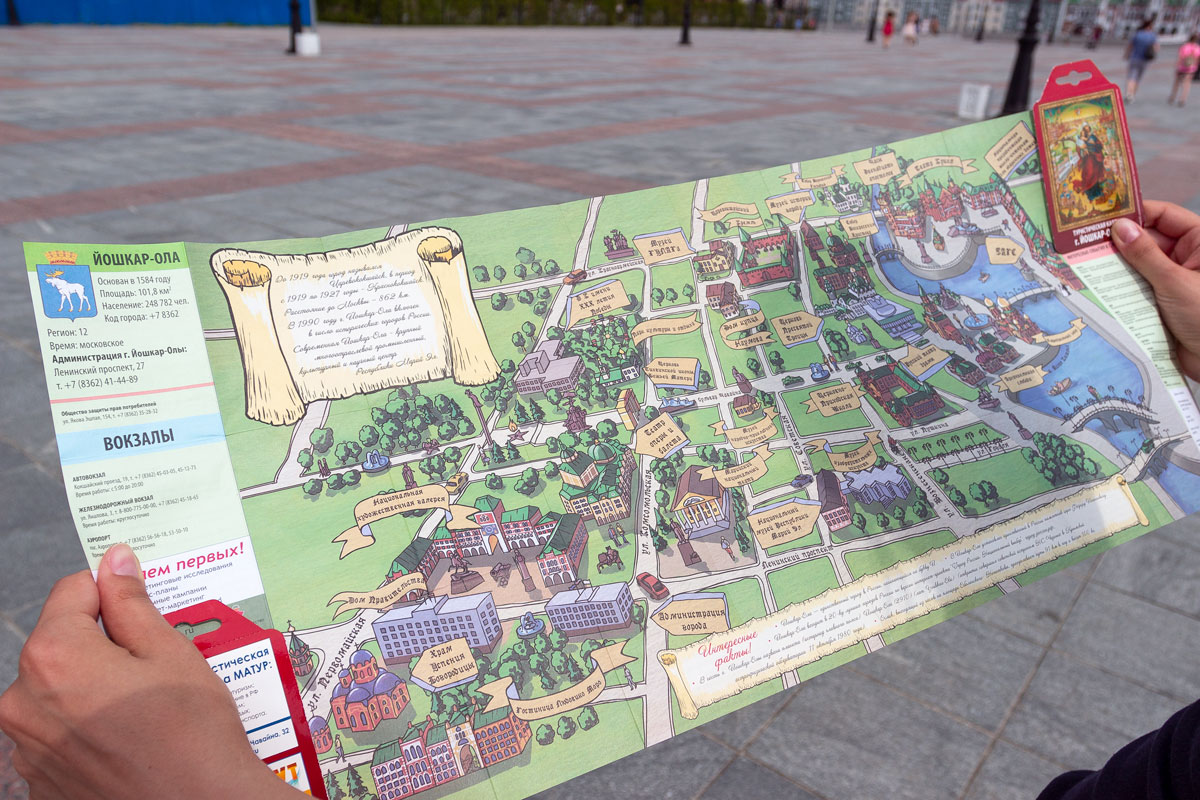
The brick chaos doesn’t end in the city center; all this bloody mess seems to spill out of a cauldron, and splashes spread far across the entire city.
Here stands the building of the city administration.

Seemingly, what could be more messed up than Brezhnev-era bureaucratic nonsense with a moose in the coat of arms? But across from it, there is a large square, where stands a brick replica — of what? One of the Italian cathedrals?
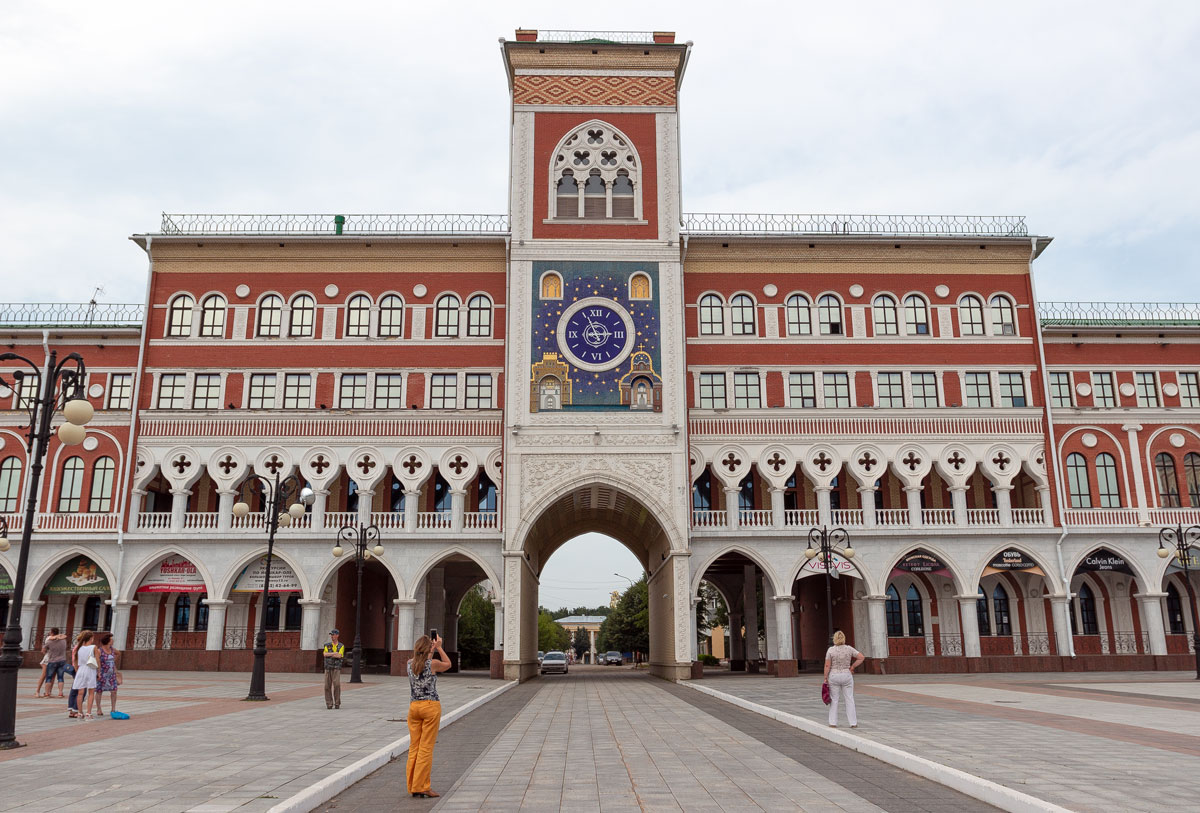
Next to it, a monument to the holy martyr Leonid has been erected.
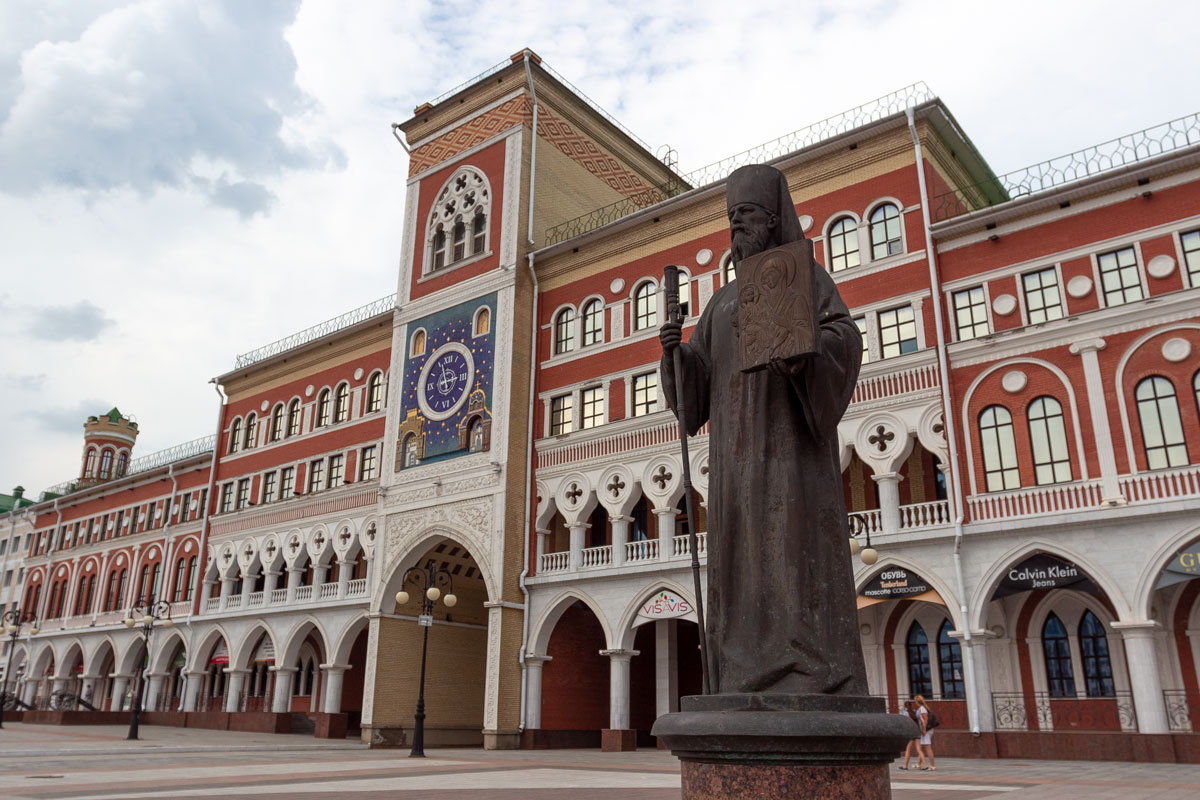
And here, finally, the veil of Yoshkar-Ola’s mystery is lifted. So that’s what it is! Holy martyr Leonid! Isn’t his surname Markelov?
And if you look at the main hotel of the city, we will see the name “Ludovico Moro.” In another place, there is a monument to Lorenzo de’ Medici. Isn’t it strange that the initials L.M. coincide with the initials of the king of Yoshkar-Ola?
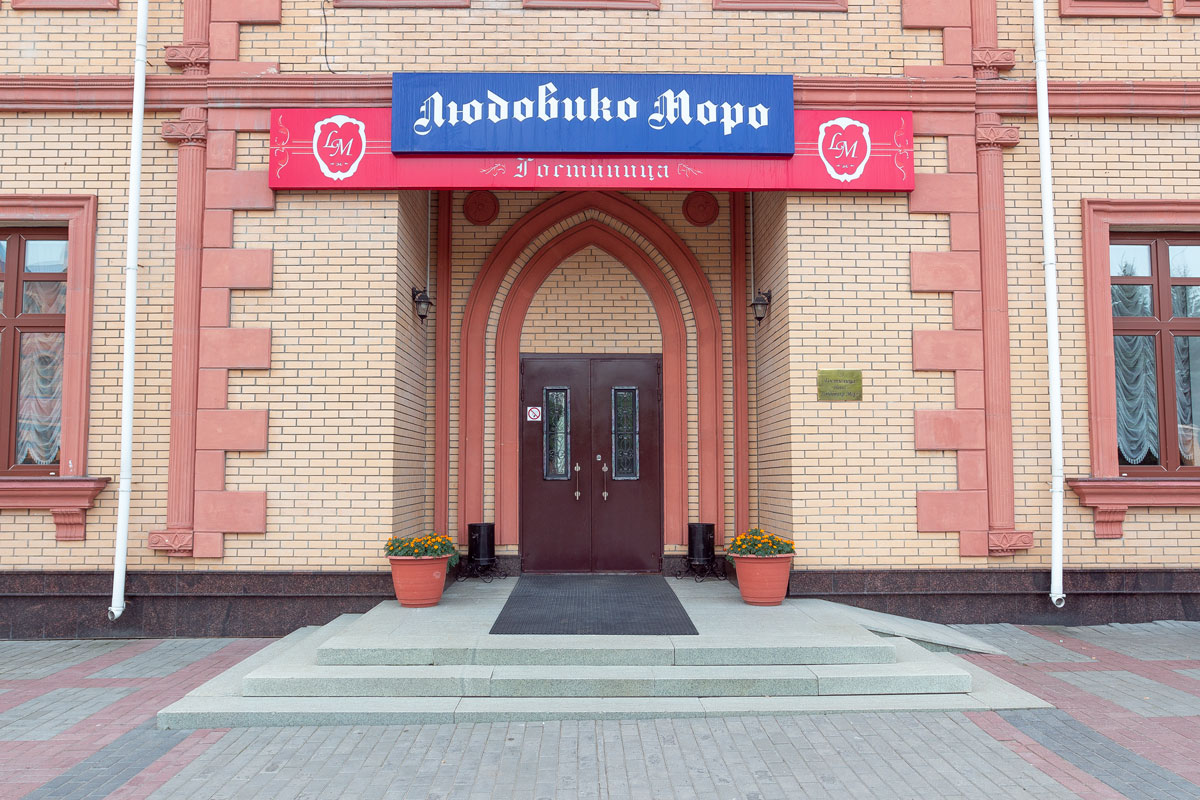
Everything aligns/fits together.
Mad poems written by Leonid Markelov, the psychopathic construction of the city with brick replicas of the Kremlin and Bruges, the initials L.M., the family coat of arms, and the monuments to martyr Leonid — all these are symptoms of a major complex that would be worth studying and documenting in a book on personality disorders.
The author, without possessing medical education, suggests the following diagnosis: messianic delusion or mild form of megalomania. It doesn’t hinder functioning but also doesn’t contribute to it.
Fortunately, even broken clocks show the correct time twice a day. And in 2017, the judicial system of the Russian Federation came into action: Leonid Markelov was arrested for bribery and transferred to Moscow, where he is still under investigation.
In prison, Markelov only confirmed his diagnosis and wrote poems dedicated to Putin himself. There is a whole poem there, so I will quote a meaningful excerpt:
My sorrow is immeasurable,
And, truth be told,
I continue to believe
In a just Tsar.
I believe in God and pray,
And ask for forgiveness.
I hope to survive
And raise my children.
Only one path is left for me,
'Our Father in Heaven,'
For the President of all Russia
To understand my plight.
To pardon is the prerogative
Of righteous rulers.
Their divine field —
To forgive people for their sins.
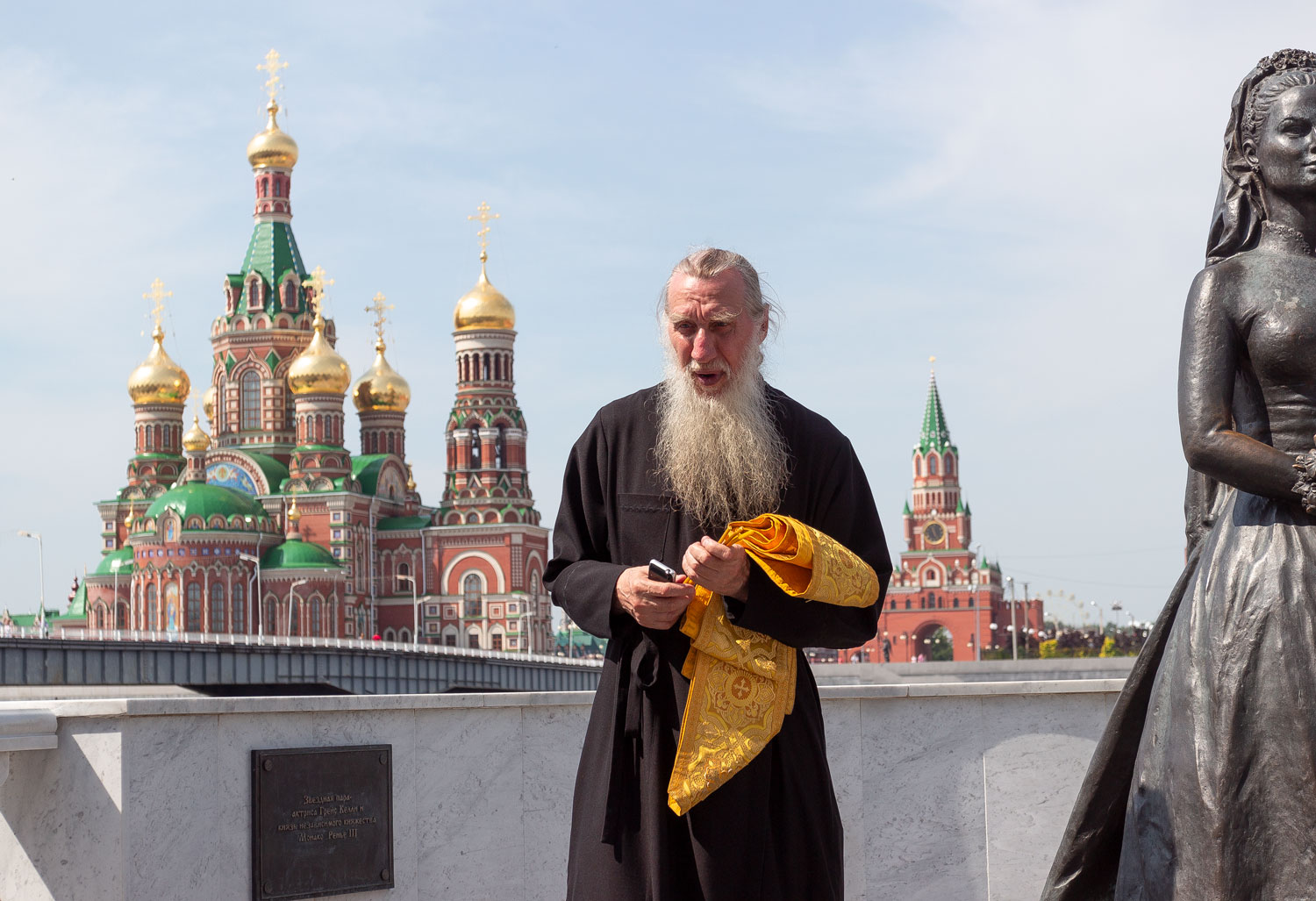
Long live Yoshkar-Ola.


